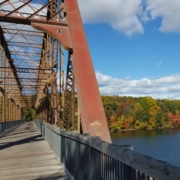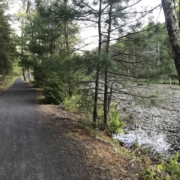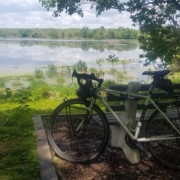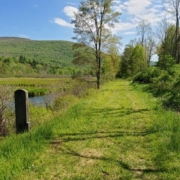Riding the Maybrook Trailway
/in Bike Paths, Hudson Valley, Rail Trails /by Laura Willis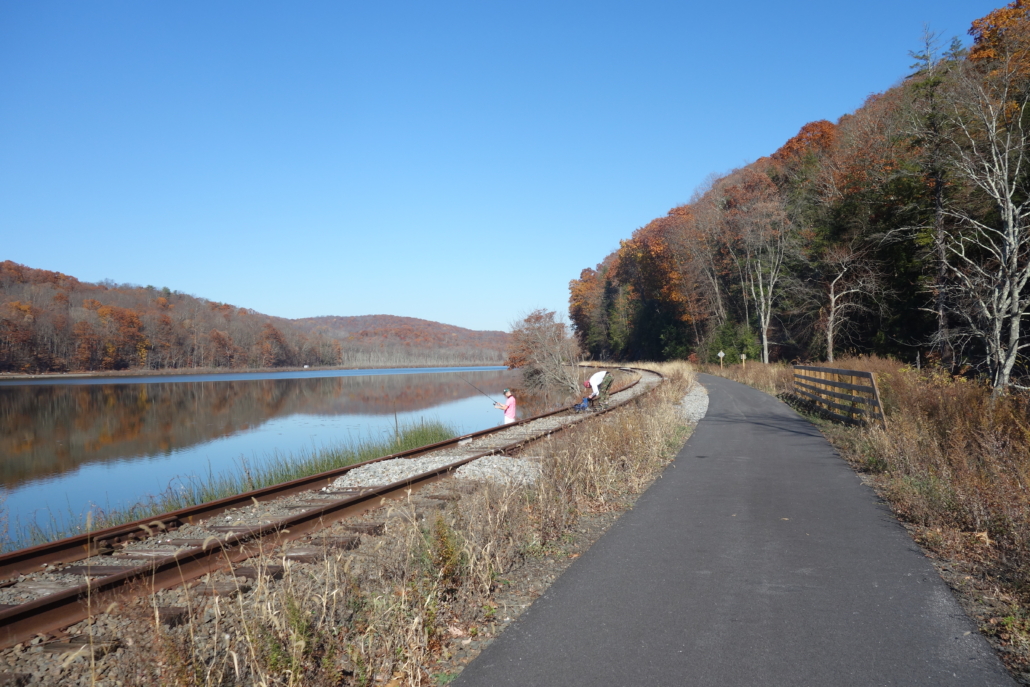
The Maybrook Trailway is the newest rail trail in the lower Hudson Valley and it is also the very eagerly-awaited “missing link” of trail between the former Putnam Division Railroad trailway system (also known as the Putnam Trailway, North County Trailway, South County Trailway and Putnam Greenway depending on where you are) and the trail system centered around the Walkway-Over-the-Hudson (which is comprised of the walkway itself, the Dutchess Rail Trail, the Hudson Valley Rail Trail and the Wallkill Valley Rail Trail). With the construction of the Maybrook Trail, it is now possible to ride continuously on a bike path (with no cars) between New York City and Kingston – almost 100 miles! All of this is part of the new Empire State Trail which goes across the entire state (although not all of the Empire State Trail is bike paths).
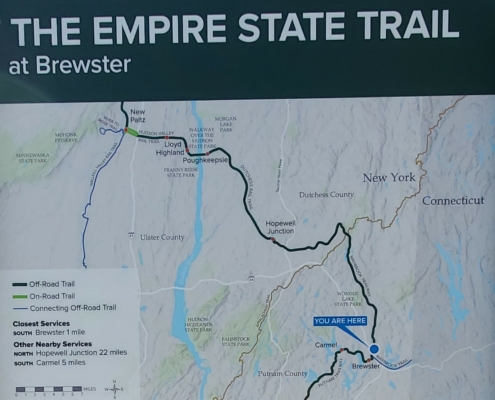
The Maybrook Trailway travels between Brewster and Hopewell Junction for 24 miles. There are no services available or restrooms.
The Maybrook Trailway has been a long time coming. Instead of being a “rail trail’ the Maybrook is actually a “rail with trail” traveling alongside the Maybrook Line owned by Metro-North Railroad. The trailway itself is also owned by Metro-North, which makes it one of the only bike paths to our knowledge to be owned and operated by a commuter railroad. The uniqueness of this arrangement also makes for a very unique trail experience, as you travel through very remote areas that are only accessible by this rail line. Far from development and traffic, the Maybrook Trail offers a quiet experience with the sounds of birds and wildlife as a soothing soundtrack in the background. In fact, the Maybrook Trailway is probably one of the most scenic bike paths in our entire region.

Wide open and quiet, with only the sounds of nature surrounding you.
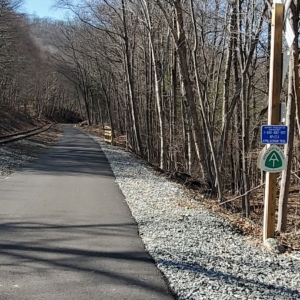
The Maybrook was a mountain railroad, crossing the Appalachian Trail.
However, this sense of solace comes at the expense of convenient services. There are no easily accessible services anywhere along the trail and there are no restrooms along its entire 24 mile length. So you need to go into this ride prepared, or you could consider one of our tour packages where we provide rest stops and services to our riders. There are also no places to sit along this trail except for the stone boulders placed near road crossings. This is a shame since there are so many pretty views that would be nice to sit and enjoy.
As you would expect from a transit agency, the Maybrook Trailway has lots of clear signage. Most of this involves telling you what you can’t do: don’t go on the tracks, stay off of private property, don’t swim in this lake, etc. But there are also lots of great informational panels telling
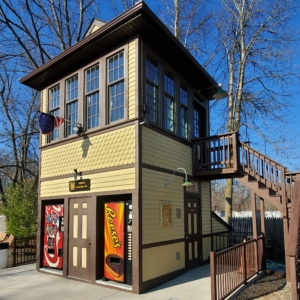
Although there are no services or restrooms along the Maybrook Trail, when you reach the end in Hopewell Junction, there are restrooms and vending machines.
you about railroad history and the many settlements that you pass. Also, because the Maybrook Trailway goes along train tracks that connect to the Brewster rail yards, you can easily take Metro-North railroad from NYC with your bike to get to the trail. It’s also possible to ride the 44 miles to Poughkeepsie (via the Dutchess Rail Trail) and then take the train back to the city via the Hudson Line while you watch the sun set over the Hudson River. Discount rail fare is available for this excursion with our tour package.
New York Metro Area Bike Paths That Are Great for Cross Country Skiing
/in Bike Hacks, Bike Paths, Hudson Valley, Rail Trails /by Laura Willis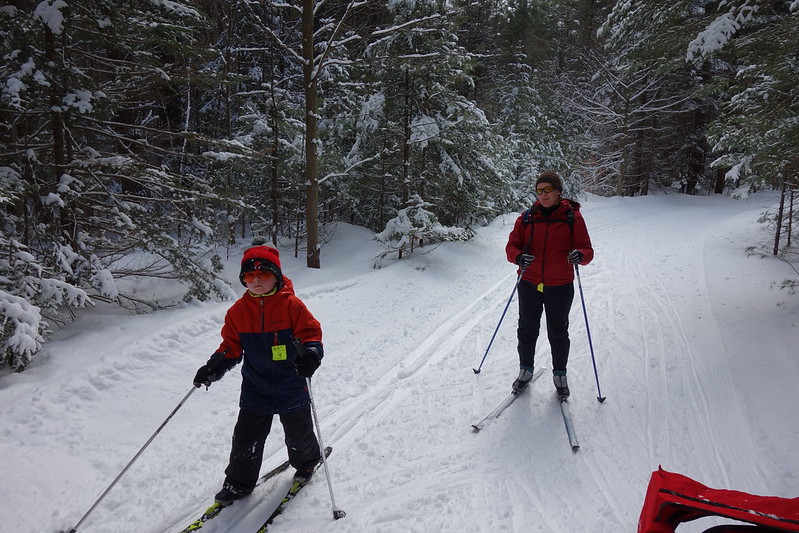 There’s nothing quite like getting outside on cross country skis after a fresh snowfall. When you can’t get out for a bike tour, cross country skiing is a great form of exercise, since you work both your upper and lower body at the same time. Plus it’s beautiful to ski through a winter wonderland where snow is sticking to tree branches. Unlike downhill skiing, cross country skiing can perhaps best be described as a faster version of hiking where you glide along a trail using your own power to move. But of course those downhills are always a fun part of any day out. The New York area has many biking and hiking paths that offer a wide range of cross country skiing experiences from easy to difficult. There are also a few paths that follow train lines that allow you to ski one way and take the train back to where you started.
There’s nothing quite like getting outside on cross country skis after a fresh snowfall. When you can’t get out for a bike tour, cross country skiing is a great form of exercise, since you work both your upper and lower body at the same time. Plus it’s beautiful to ski through a winter wonderland where snow is sticking to tree branches. Unlike downhill skiing, cross country skiing can perhaps best be described as a faster version of hiking where you glide along a trail using your own power to move. But of course those downhills are always a fun part of any day out. The New York area has many biking and hiking paths that offer a wide range of cross country skiing experiences from easy to difficult. There are also a few paths that follow train lines that allow you to ski one way and take the train back to where you started.
In most cases, to ski any of these trails you will need to have your own cross country skis. While this may seem like a major purchase, XC skis cost much less than downhill skis and they will last you many years. Major retailers that sell them include REI and L.L. Bean. There are also a few local retailers who sell them, including Pawling Cycle & Sport and Rock & Snow, both in the mid-Hudson Valley. Rock & Snow also offers rentals if you aren’t ready to buy yet.
Fahnestock Winter Park
Fahnestock Winter Park is perhaps the best choice for New Yorkers who are looking to try cross country skiing for the first time, or if you don’t have equipment. Every winter, the beach area, campground, and hiking trails in Fahnstock State Park are transformed into a nordic skiing center whenever we get a big snowfall. Groomed trails range from easy to difficult and they have rental skis and lessons available. This is the closest nordic skiing center to NYC, so it can get a little crowded. But it is also super easy to get to since it is right off the Taconic State Parkway. You can also get here by public transit by taking the Metro-North Railroad to Cold Spring and then cabbing it over.
Bronx River Pathway
If you are looking to just get out for a short ski trip, you can’t beat the Bronx River Pathway in Westchester County for convenience. This bike path parallels the Metro-North Harlem Line and the Bronx River Parkway so it’s easy to get to by car or train. Plus it offers the advantage of a one-way trip where you can use the train to get to a starting point and then ski back. The scenery is super nice as you pass through dense woods. The nicest segment for skiing is between Hartsdale and White Plains since it has a fair amount of up-and-down and there are no road crossings. If you are looking for a flatter section, try the area between Bronxville and Scarsdale.
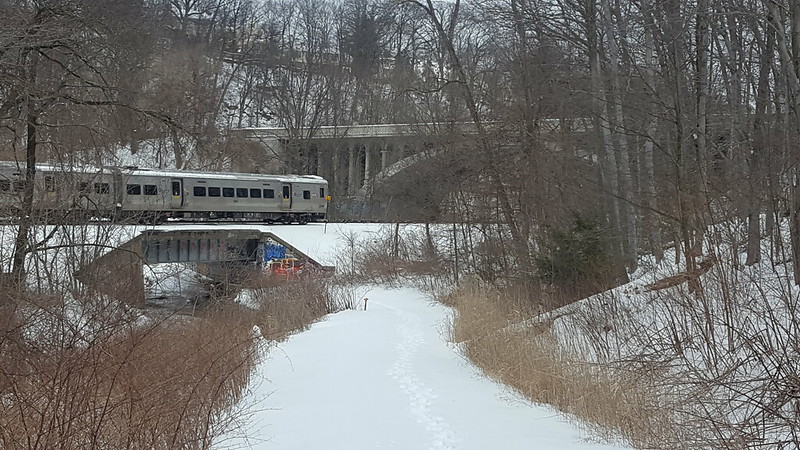
The section of the greenway just south of White Plains is great for cross-country skiing when it snows.
Old Croton Aqueduct
With the leaves off the trees, you get a near constant view of the Hudson River and the Palisades from the Old Croton Aqueduct bike trail through Westchester’s river towns. This trail is consistently flat and, since it parallels the Metro-North Hudson Line, it is also very easy to get to by train or do a one-way ski. You also pass through many town centers, which make it easy to stop for lunch.
Rockefeller State Park Preserve
Another regional hot spot for cross country skiers is Rockefeller Preserve in between Pleasantville and Tarrytown in Westchester. This park features a large network of carriage trails that are primarily used by hikers and horseback riders. But after a snowfall it becomes a prime local destination for cross country skiers who ply its ungroomed trails. Probably one of the most scenic parks in our region, this is a great place to check out. You could also get here by train to Tarrytown or Pleasantville in combination with a cab ride.
Ward Pound Ridge
Similar to Rockefeller Preserve, but further north, is Ward Pound Ridge Reservation, which also has a large network of carriage trails that are perfect for cross country skiing. The park isn’t far from the Katonah Metro-North Station, which also has taxi service.
Westchester County Golf Courses
If skiing across open landscapes instead of wooded trails is more appealing to you, all six of Westchester County’s golf courses are open to XC skiing and sledding. These golf courses offer a mix of terrain from steep hills to flat fairways, so there is something for every ability. Plus the parking lots are always plowed and you can even take Bee-Line buses to the Dunwoodie and Saxon Woods Golf Courses. (For Saxon Woods, your best bet is to take the bus to the pool parking area where you can access the parks hiking trails which are also good for skiing).
High Point Cross Country Ski Center
Finally, if you are looking for another large nordic center, but you are willing to travel a little further, High Point Cross Country Ski Center in New Jersey is another place where ski rentals (and even snowmaking and night skiing!) is available.
Resources to find out more
If you want more guidance in figuring out where to go or where the best conditions are, there are a couple of great resources for cross country skiers in our area. Check out Ski the Northeast which is a comprehensive website for skiers from the New York Metro area. Another great resource, particularly if you are interested in updates about ski conditions and other general information, is this fantastic email forum from the New York/North Jersey Chapter of the Appalachian Mountain Club. It’s a great group to learn more about skiing and ask questions.
Riding the Esposito Trail (and the Old Erie Path)
/in Hudson Valley, Rail Trails /by Laura Willis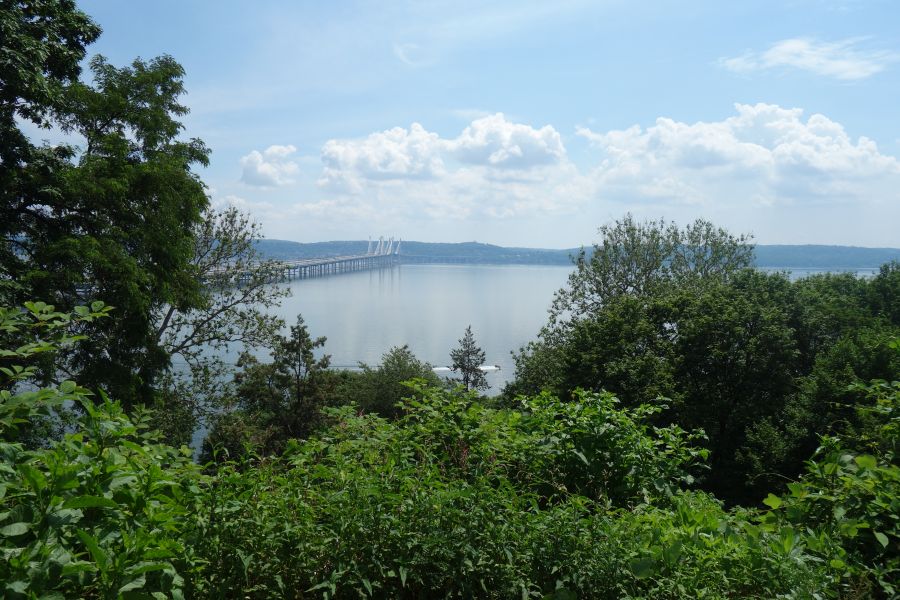
A view of the Mario Cuomo Bridge from the Esposito Trail.
If you are planning to ride across the new Tappan Zee Bridge (or Mario M. Cuomo Bridge) bike path, you are probably wondering “what other trails connect to this bike path”? Well, look no further than the Raymond G. Esposito Memorial Trail. The Esposito Trail is a great way to connect from the bridge to the Villages of Nyack, South Nyack and Piermont. This trail will also connect you to the Joseph B. Clarke Rail Trail in Sparkill via its extension called the Old Erie Path
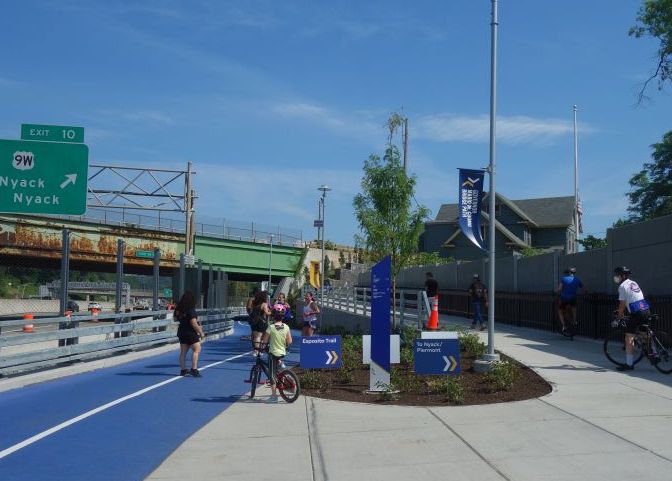
Clear signage takes you from the Tappan Zee Bridge bike path to the Esposito Trail.
The new Tappan Zee Bridge bike path is a great new amenity for cyclists in the Hudson Valley. The Esposito trail connects almost seamlessly with the bridge bike path to take you directly to South Nyack and Nyack where there are plenty of stores, restaurants, and services. These bike-friendly villages are a great place to head to after riding over the Mario M. Cuomo Bridge.
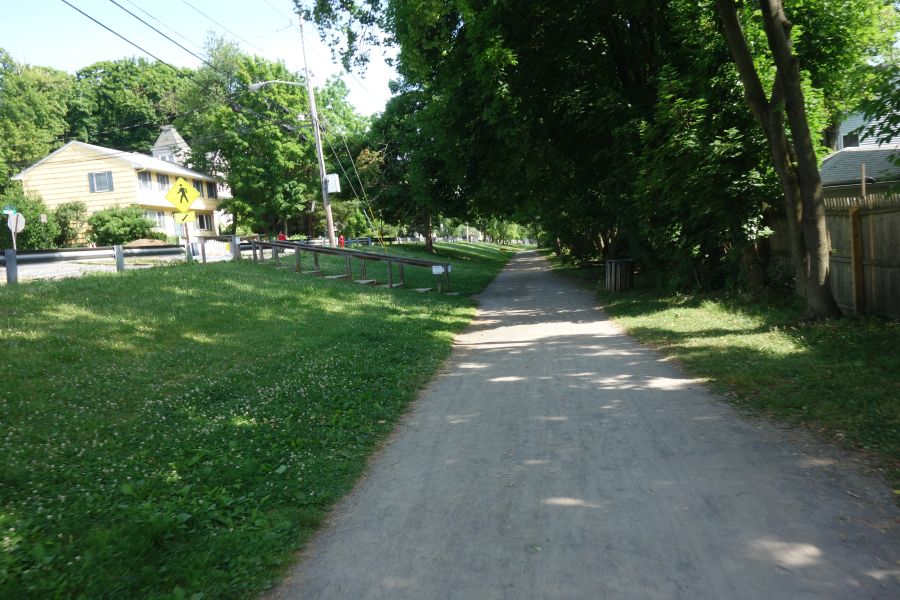
The Esposito Trail is wide and easy to ride in between the bridge and Nyack.
You can also head south on the Esposito Trail, which eventually becomes the Old Erie Path. This trail follows the alignment of the former Northern Railroad of New Jersey, which once ran passenger trains between Jersey City and Nyack. Passenger service ended in 1966, and today it’s another great rail trail for cyclists. The surface is a combination of dirt and gravel, so make sure you ride this with either a hybrid bike or a mountain bike. Sturdier road bikes should also do okay.

Watch out for narrow sections like this one. One way only!
While the trail is generally wide and smooth north of the bridge, as you move south, it gets bumpier and narrow. There are a couple of spots where the trail becomes very narrow and it’s one-way at time, so be aware of people coming in the opposite direction!
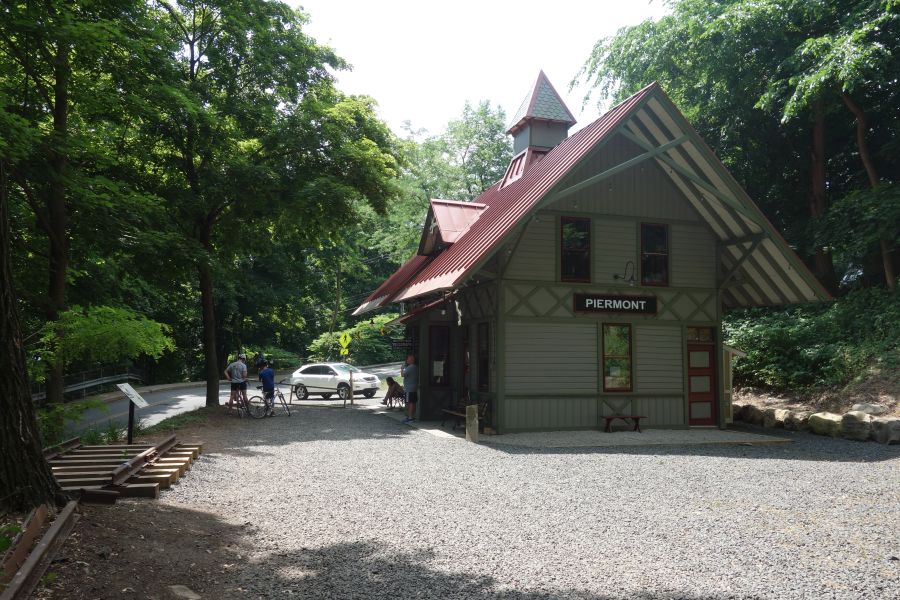
Check out the beautifully restored Piermont Station.
When you reach Piermont you will see a beautifully restored station. Keep riding south and you will eventually get to the hamlet of Sparkill where you can easily pick up NYS Bike Route 9 which takes you to the George Washington Bridge. Sparkill once had a major junction of railroads in its center….which is now a major junction of bike paths. From here, you can get on the Joseph B. Clarke Rail Trail and ride further. Or you can stop and get lunch here at one of several restaurants. With the connection to Bike Route 9, the Esposito Trail can be a great part of a circular route that features the Old Croton Aqueduct, the Mario M. Cuomo Bridge and Bike Route 9 back to Manhattan via the George Washington Bridge.
Riding the O&W Rail Trail
/in Bike Paths, Hudson Valley, Rail Trails /by Laura WillisThe City of Kingston sits right next to the Catskill Mountains along the Hudson River. But it also sits at the end of two river valleys that run south to north. These two waterways: the Roundout Creek and the Wallkill River, have their confluence just south of Kingston. From that point north, the Roundout Creek becomes a navigable waterway which leads to the small harbor that made Kingston a hub of industrial activity in the Mid-Hudson Valley.
The Roundout Valley has long been a transportation corridor. First it was the Delaware and Hudson Canal that once transported coal between northeast Pennsylvania and the Hudson River. Later the canal was replaced by the New York, Ontario and Western Railway (the O&W). And now that railroad alignment is another great bike path for you to explore. Riding this trail can be a great component of any of our Hudson Valley bike tours. You could also combine it with our Catskill Scenic Trail tour and make a weekend out of it.
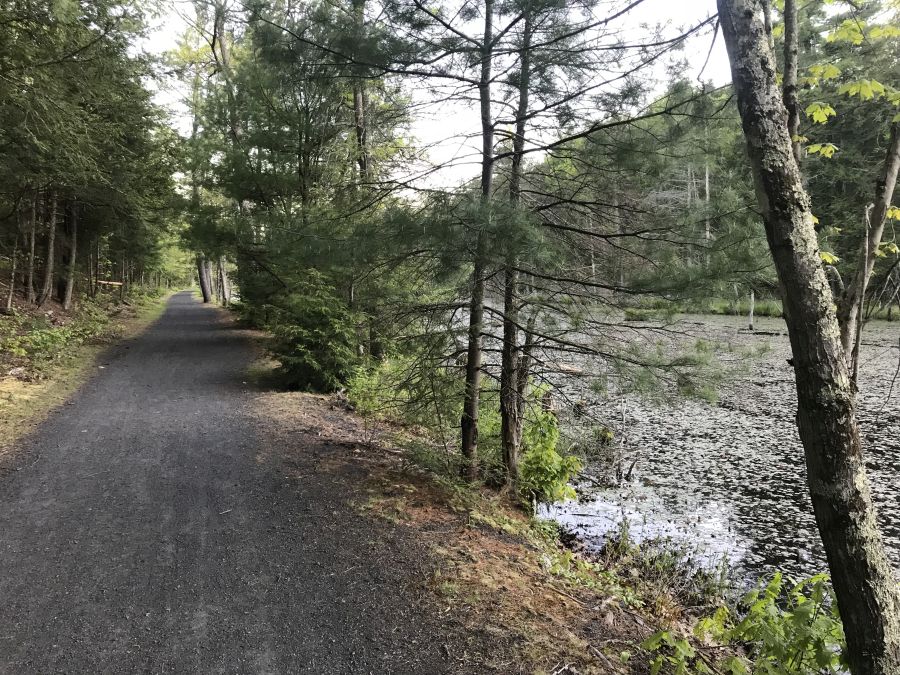
The O&W is a quiet, peaceful ride. But it is still a work in progress in many ways. There are a number of gaps in the trail, and some parts of the ride are kind of rough. So you will definitely want to ride a hybrid bike or a mountain bike if you want to experience any of the rough parts. There is a good map showing the different segments (and gaps) on the trail’s official website. The map also shows a number of parking areas as well. You can also take public transit to parts of the O&W trail by using Route EU of the Ulster County Area Transit bus system. These buses are equipped with bike racks and can help you ride this route one-way, and take the bus back to your start point.
Perhaps the roughest section of the trail is in Kingston where the O&W met the other lines that made Kingson a regional rail hub. The trail begins in the parking lot of the Super 8 hotel where the O&W once joined the tracks that are still in use by the Catskill Mountain Railroad. Riding the trail in this area is basically riding on bumpy grass, and it can be tough at times. If you want to skip this area, you can start instead at the parking lot just off of Route 209 in Hurley. From here south, the trail conditions begin to get better and it is a nice quiet ride through beautiful woods with great scenery. Although there are a couple of rough spots on the trail here and there. Once you reach High Falls, you will begin to ride along the Roundout Creek where you can see remnants of both the D&H Canal as well as the O&W Railroad.
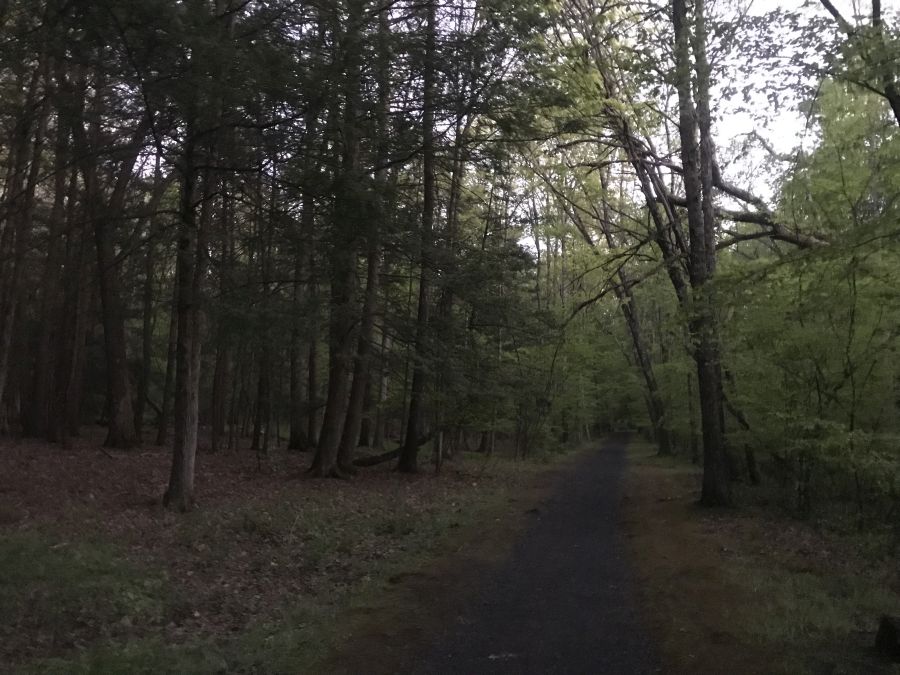
Typical trail conditions on the O&W Rail Trail
There aren’t a lot of services or stores immediately next to the trail. So you’ll want to pack some food to bring with you. If you need to stop for supplies, your options are basically in Hurley, near the parking lot at the north end, and at Big E’s deli where the trail crosses Cottekill Road. There are also some shops in High Falls if you get off the trail and cross the Roundout Creek.
This section of trail is more or less continuous until you reach the hamlet of Accord, where the trail peters out in a lumberyard. From here you will need to continue along Lucas Turnpike and Route 209 if you want to keep going. These roads can be kind of busy and aren’t the greatest for riding, but more advanced riders should be OK.

A view of the Shawangunk Ridge from the O&W Trail
When you reach the center of Accord, you will need to go through town and cross the Roundout Creek. There aren’t that many stores or services here, despite it being the center of town. You will need find your way over to Rochester Town Park by taking County Road 27 to get to the next segment of trail. But you may have to ride through the park for a while until you can figure out where the trail is. Just look for the dump trucks and the trail should be behind them. The trail is kind of rough here again, and it only goes for 4.3 miles until the next gap in the trail in Kerhonkson. But you will ride along the Roundout Creek the entire time with great views of the Shawangunk Ridge.
In Kerhonkson, if you want to keep riding, you’ll need to use Berme Road for 3.4 miles and it will take you to one last piece of trail – 1.2 miles in Ellenville. But it’s still a nice ride! Kerhonskon also has a couple of restaurants, a brewery and a resort hotel making it a nice place to end your ride as well.
Riding the Union Transportation Trail
/in New Jersey, Rail Trails /by Laura Willis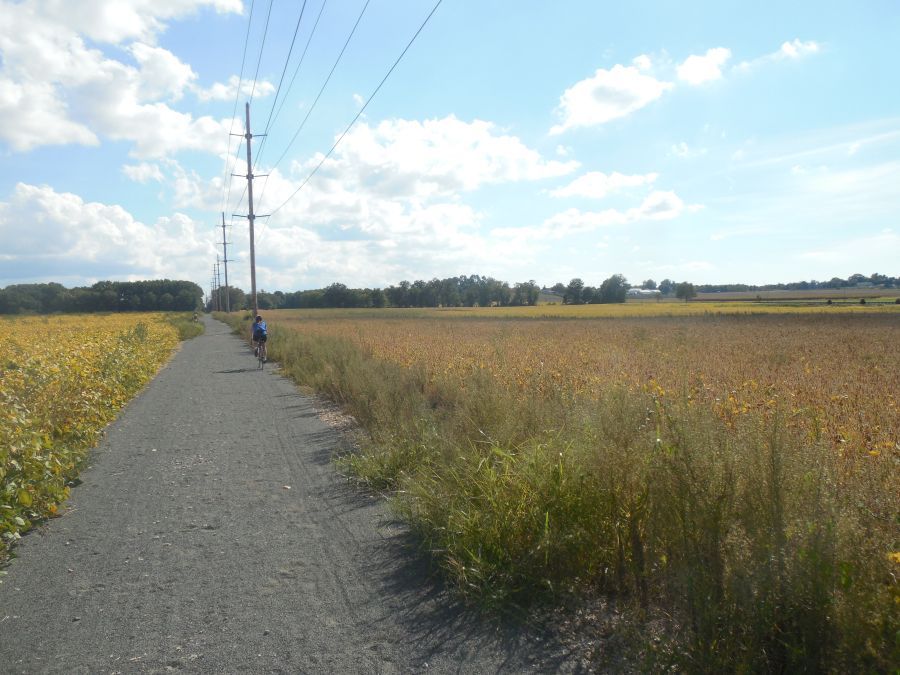
The Union Transportation trail is a flat rail trail that goes through wide farming areas.
If you are looking to get away for a ride that is rural and beautiful, yet isn’t super far from the NYC or Philadelphia metro areas, you can’t beat the Union Transportation Trail, or UTT for short. This is a 9-mile long rail trail that can easily be combined with quiet back roads to make a nice loop. In fact, we prominently feature this trail on our Tour des Vins de New Jersey.
The UTT trail is a gravel/stonedust surface and is generally flat for its entire length. While it is ideal for hybrid bikes and mountain bikes, some road bikers may find the surface to be too loose to ride comfortably. But this trail is best enjoyed at a relaxed pace since there are so many scenic vistas to enjoy.
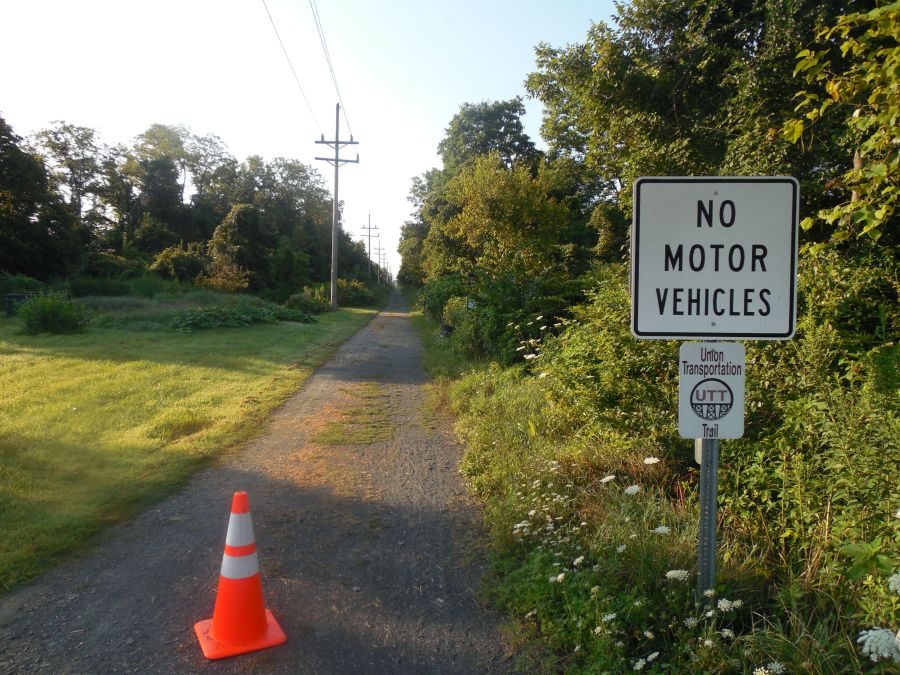
A typical road crossing on the UTT trail.
The UTT trail generally travels across Upper Freehold Township, located in the western panhandle of Monmouth County. It’s not really practical to take public transit here, although you could potentially ride to this trail from either the Trenton or Hamilton NJ Transit rail stations if you like riding longer distances. The trail is currently being extended further south into the New Egypt hamlet of Plumsted Township, which will take trail users directly to the shops and services located there. So once this extension is developed, it will be a nice 20 mile ride if you park at the north end of the trail at Herbert Road and ride the 10 miles to New Egypt, take a break and ride back. If you want to ride a longer distance, you can’t go wrong with signing up for the Tour des Vins de New Jersey which is a 35-mile ride which also explores the Assunpink Wildlife Management Area as well as two wineries. We have been partnering with Cream Ridge Winery for many years on our rides, and they are only a short distance off of the trail.
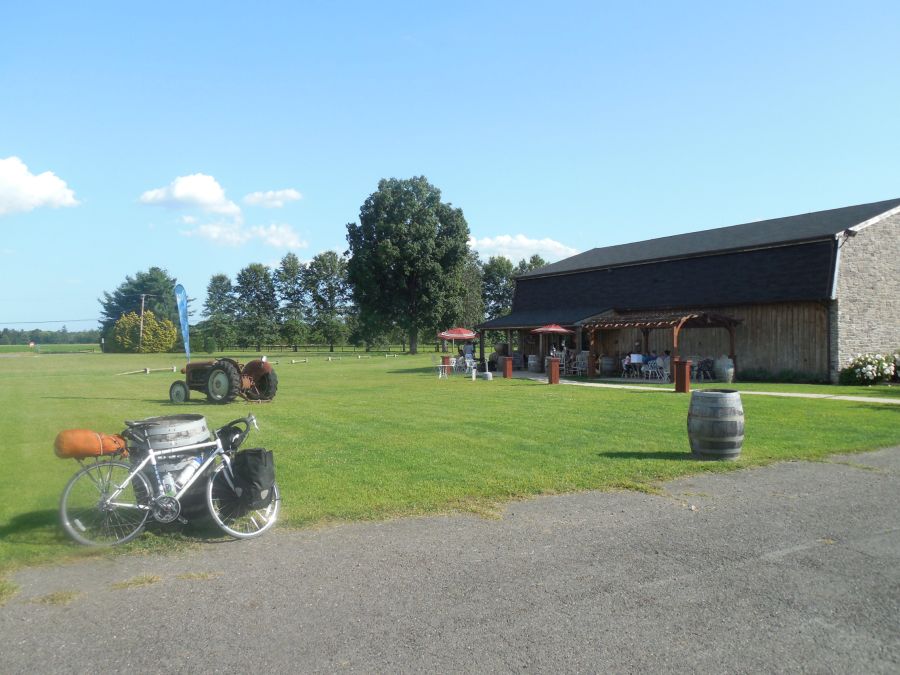
Make sure you stop at Cream Ridge winery. It’s close to the trail, about halfway.
When you are on the trail, there really aren’t any services or restrooms, except near the south end in new Egypt, so plan accordingly. Also, on hot summer days, be aware that you are very exposed on this trail because you are going through a lot of flat farming areas. So sunscreen and plenty of water are a must for summer rides! Also keep in mind that horses also use this trail, so you will encounter piles of horse manure as you ride. If you are riding and you see someone on a horse, please stop and let the horse pass!
Check out the official webpage for the trail here.
Riding the South and North County Trailway
/in Hudson Valley, Rail Trails /by Laura Willis
If there is one bike path that most closely resembles a trunk-line, main artery for bikes in the Hudson Valley region, it is the South and North County Trailway in Westchester County. This trail, which runs continuously from Bronx/Yonkers border for almost 50 miles to the Village of Brewster in Putnam County, is the centerpiece of Westchester’s trail network and one of the most popular parks in this part of the region. It also features prominently in our Hudson Valley Craft Brewery Bike Tour, which is our most popular tour.
Although this trailway is typically viewed as one long bike path, it is technically made up of four separate trailways with different names (and different maps). The South County Trailway runs between Van Cortlandt Park at the Bronx/Yonkers border to Old Saw Mill River Road, which is the border between the Towns of Greenburgh and Mount Pleasant. North of Old Saw Mill River Road, the path is the North County Trailway until you get to the border between Putnam and Westchester Counties where the path becomes the Putnam Trailway. The southernmost segment of the trail, which goes through Van Cortlandt Park in the Bronx, is named the Putnam Greenway.
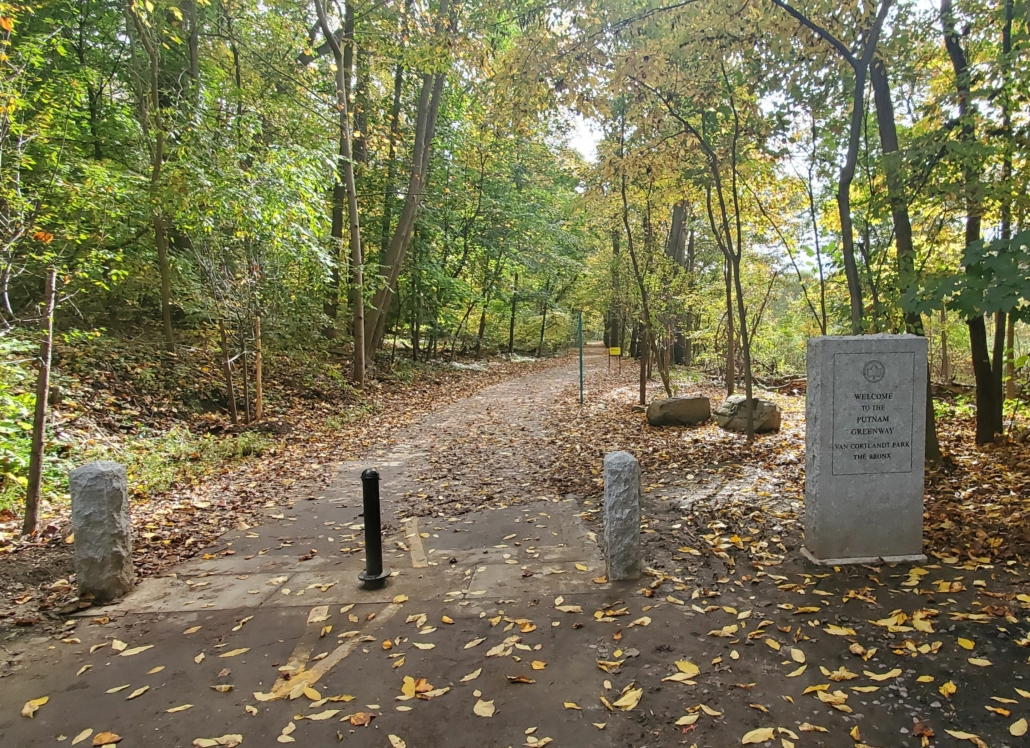
A stone marker lets you know you are crossing into New York City on the Putnam Greenway.
Although the name changes four times, and you need four different maps for it, the trailway is basically the same throughout. This was once a train line, known as the Putnam Division of the New York Central Railroad. It was first constructed as the New York City & Northern Railroad in 1881 when mining operations were abundant in Putnam County. Passenger service continued until 1958, but it was never as successful as the Harlem or Hudson lines (both of which continue as Metro-North train lines today) probably because riders needed to transfer in the Bronx to continue their trips to Manhattan. After passenger service ended, freight service continued until 1982 at which point the right-of-way was transferred to the New York State Department of Transportation. Then Westchester County and Putnam County both constructed trailways on the alignment as county parks. The New York City portion of the right-of-way remained a dirt path until it was finally paved in 2020.
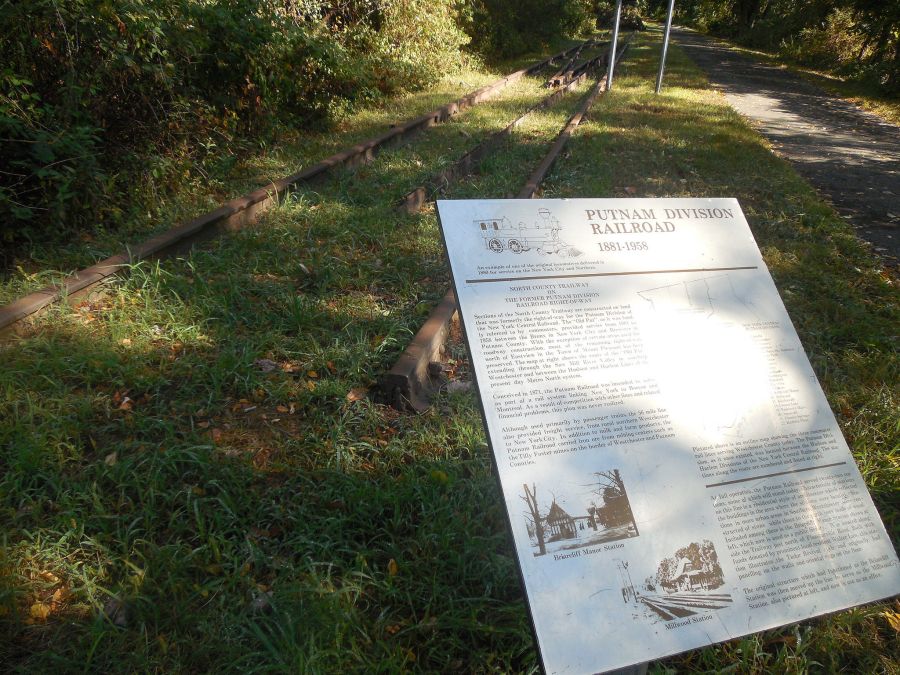
Historic panels along the trailway tell you about long lost train stations.
This trailway corridor has been constructed piece-meal over several decades. The first segments were constructed by Westchester County in the 1990’s. The last piece was opened in 2017. What this now means is that there are sections that are relatively new, and in great shape….and there area also old sections that are in very rough shape. The conditions can change dramatically as you ride. The good news is that some of the older sections are now being reconstructed and are better than ever. The bad news is that this construction will take many years to reach all of the spots that need it, so some of the segments will stay rough and bumpy for a while longer. You’ll also have to deal with interruptions in the trail due to construction.

Uh oh…a surprise construction closure means you get to make a detour. At least this part of trail will be brand new the next time you come back.
If you are looking to ride the trail, the good news is that there are many parking lots along the path. Parking lots are shown on the various maps for the trail. Biking to the trailway from somewhere else can be hit-or-miss, depending on where you are. Many of the roads that cross the trail are busy and have no shoulders on them, since this trail goes right through the heart of car-oriented suburbia. The only nearby public transit options are at the south end (the #1 subway at Van Cortlandt Park) or the north end (the Brewster Metro-North station). So transit works well if you want to do a 50+ mile ride. If not, you’ll probably end up riding “out and back” from wherever you parked your car. The only way to do a shorter distance as a one-way ride using transit is to do our Hudson Valley Craft Brewery Bike Tour, where we shuttle you back to the train after riding 35 miles.
When riding this trail, you will also need to carefully think about services, since there are long stretches with no restrooms, stores or restaurants. So you may need to pack a lunch or at least plan where you may want to buy it as well as think about bathroom breaks. This trail is busy, and often times there is little room on each side of the path, so sneaking into the woods to pee isn’t always an option. (Again, another advantage of our bike tour…we tell you where the restrooms are and we arrange a picnic lunch for you.)
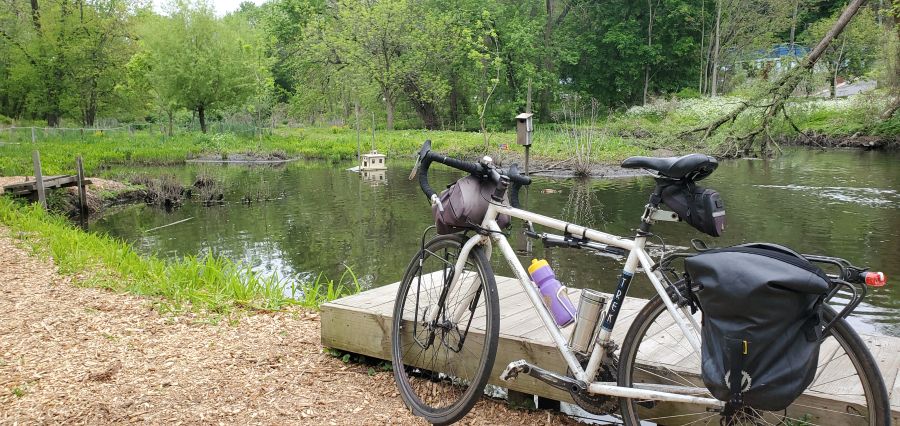
A beautiful spot to take a break along the Saw Mill River and observe wildlife.
This trailway also has an interesting relationship with the towns it goes through. Most of the South County Trailway is along the Saw Mill River, often squeezed between the river itself and the Saw Mill Parkway. So these were industrial areas, not downtown areas. Most of the factories are now gone, having left decades of pollution in the muck of the Saw Mill River next to empty brownfield sites, some of which have been redeveloped. One site was redeveloped with a shopping center with a variety of restaurants and a Starbucks. So that makes a good break stop, although you will have to get across the Saw Mill Parkway at a traffic signal.
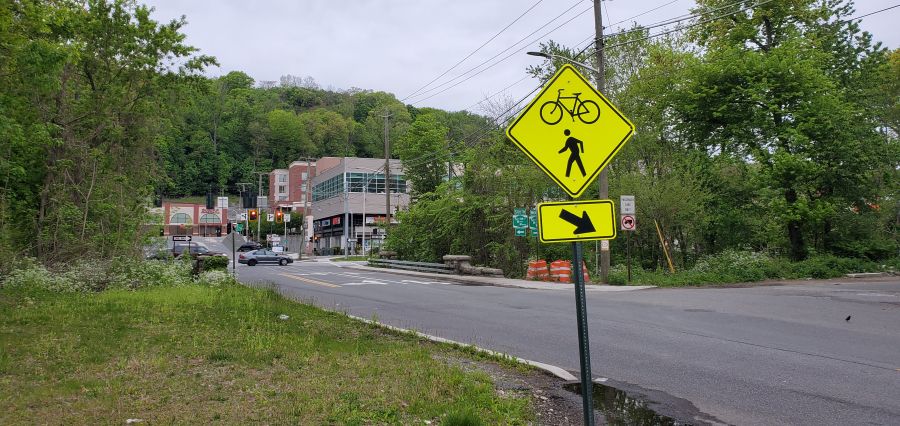
A shopping center is located on the other side of the parkway from the trail. Cross at the light to get there.
While the South County Trailway goes directly through the downtowns of two villages (Ardsley and Elmsford) the immediate areas surrounding the trailway are still industrial and you’ll need to ride around (on busy roads with no shoulders) to find that Dunkin Donuts with the bathroom or that pizza shop for lunch. Ardsley is particularly tricky since the only access point to the Village is through a school bus depot and it’s a tangle of roads to get to the main part of town.
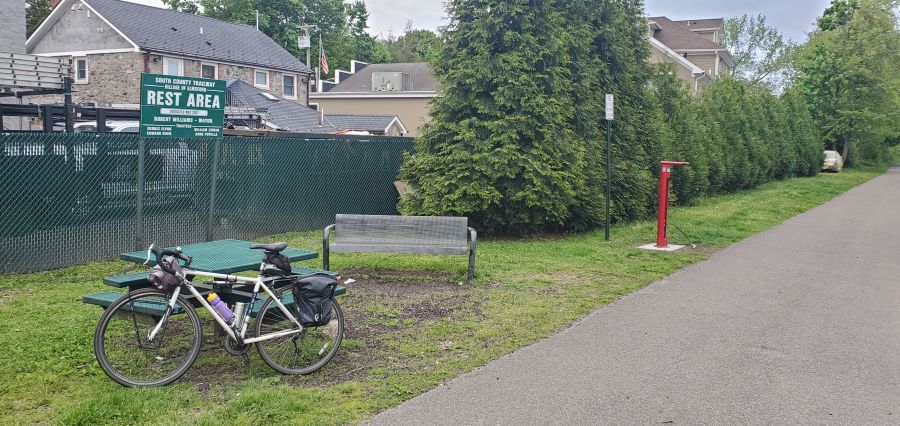
The Village of Elmsford welcomes you with this picnic area and bike repair station. There is no restroom here.
The North County Trailway does a little better in terms of taking you through downtown areas with restrooms and lunch places. The old Briarcliff Manor train station was converted into a library, and it is a great stop for a bathroom break (but there are no stores). Further up the line, Millwood has convenience stores, a deli and a supermarket. But perhaps the easiest towns for services are Yorktown Heights and Mahopac since the trail goes right through the center of those places. Yorktown Heights is one of the few places left where an old train station building remains. The local chamber of commerce has also placed maps of the town along the trail to help you find nearby services while also telling you about Yorktown’s other attractions. While there are many choices here, it helps to know where to go since the town is mostly a cluster of suburban shopping centers, many of which have substantial vacancies. Finding a restroom here is also tricky. Mahopac also has a lot of choices as well as another library right along the trail (another great restroom stop). Food choices in both towns are good, particularly if you like pizza. You get pizza that’s the real deal in these towns, although no pizza shops are directly along the trail.
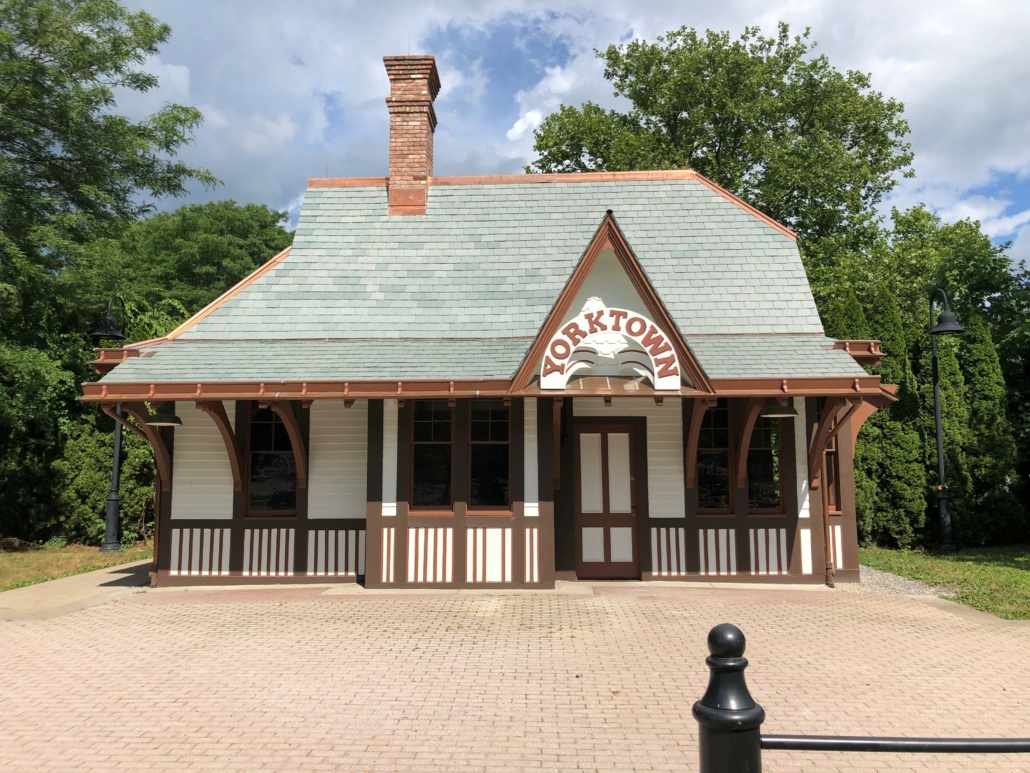
The historic Yorktown train station is currently being restored to its former glory…but it will not have a restroom for you to use.
From Mahopac and north you are on the Putnam Trailway. Although the entire corridor is a relatively flat rail trail, the Putnam Trailway has some of the steeper grades. But you will be rewarded by going through some very densely wooded areas with tall trees that burst into color in the fall. You will also get to experience a number of tall bridges as well as a causeway that goes across a reservoir. North of Mahopac you’ll go through Carmel, more or less through the center of town, but not always super close to businesses. And again, there are no restrooms along the trail.
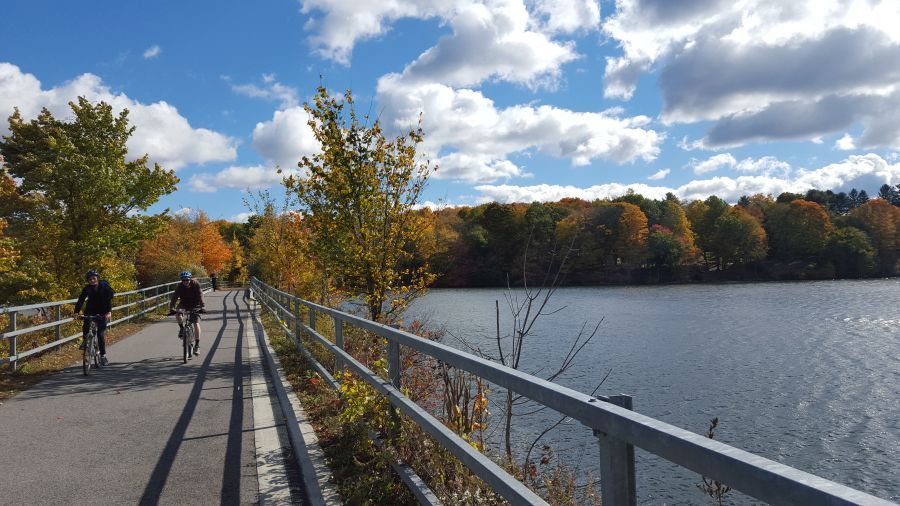
The crossing of the West Branch reservoir is another highlight of this great bike path.
The trailway ends unceremoniously in the Village of Brewster across from Miggins Screw Products and the entrance to the Metro-North rail yard for the Harlem Line. To get to downtown Brewster (and the train station) you will have to ride over a steep hill and then on a busy road to reach the center of the village. There are a number of restaurants and stores here. The Brewster train station also has a restroom, but it is often out of order, so don’t count on it.
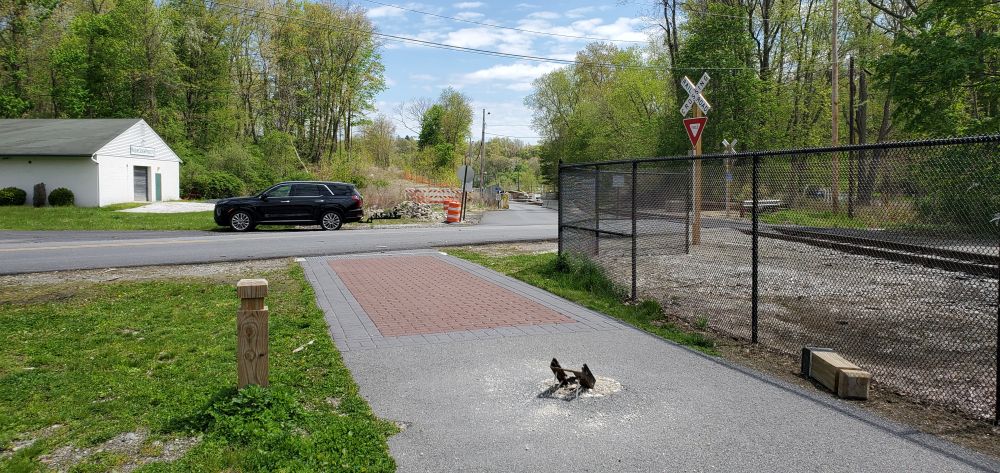
The trail ends unceremoniously across from Miggins Screw Products, next to the Metro-North rail yard.
Riding the Sussex Branch Trail
/in Bike Paths, New Jersey, Rail Trails /by Laura Willis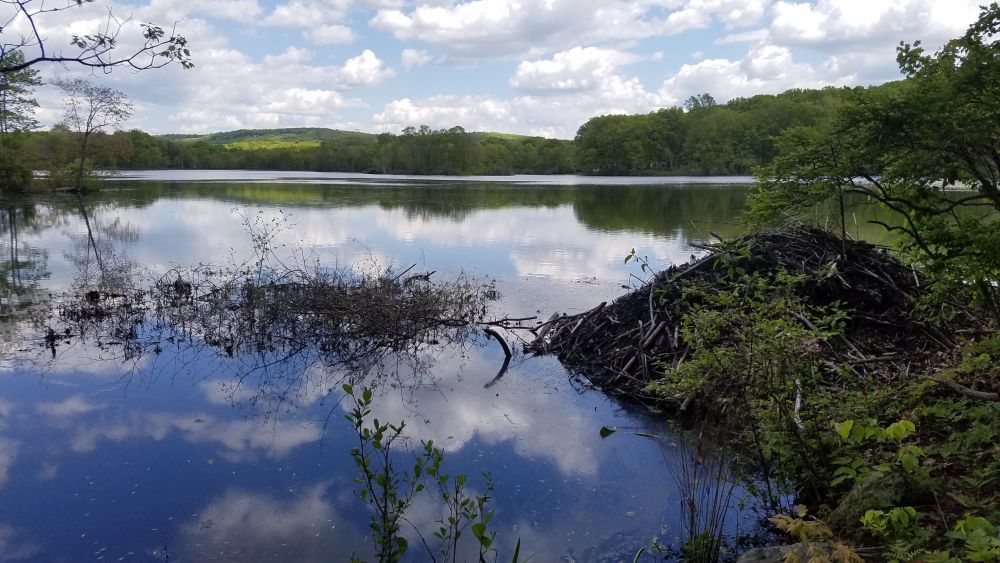
A beaver lodge on a reflective lake: one of many nature scenes on the Sussex Branch Trail
If you are looking to ride your bike on a rail trail that offers a great deal of solitude, check out the Sussex Branch Trail, which as the name suggests, is located in Sussex County, New Jersey. This trail is 18 miles long, unpaved, and goes through many quiet areas where you can easily spot wildlife. This trail is also a great feature of our New Jersey End-to-End bike tour.
While the Sussex Branch trail is generally flat, thanks to the fact that it was once the Sussex Branch line of the former Erie Lackawana Railroad, it has its “ups and downs” in terms of conditions and maintenance. The trail is not paved, and can have lots of puddles, mud and flooding if it has recently rained. In autumn, this trail is a spectacular tunnel of color, but that also means that there are leaves on the trail obscuring rocks. No matter when you go, make sure you show up with a mountain bike or a hybrid bike. Take your time and go slow. There’s no need for speed and it’s better to relax and enjoy the quiet solitude. The generally tough conditions of this trail help keep it quiet, and you may go long distances without seeing another cyclist.

One of the smoother sections of trail.
The Sussex Branch trail generally runs north-south between the Borough of Branchville and Allamuchy Mountain State Park at the southern end of Byram Township, right at the border of Morris County and Mount Olive Township. Mount Olive has a train station that is located about a mile away from the trailhead in Allamuchy Mountain State Park, so the NJ Transit Morris and Essex Line train is your only option if you are seeking to access the Sussex Branch Trail by train with your bike Be advised that the train serves the Mount Olive station on weekdays only and you will have to switch trains in Dover if you are coming from NYC.
If you are driving, the clearest parking area is at the southern end in Allamuchy Mountain State Park. Just off Waterloo Road (County Road 604) is a sizable parking lot with a port-a-potty. This is also the closest parking area to Interstate 80. But there are also other parking areas available along the route, mostly just roadside pull-offs. Consult this map produced by the Sussex County tourism organization for parking locations and other info about accommodations, and things to do near the trail.
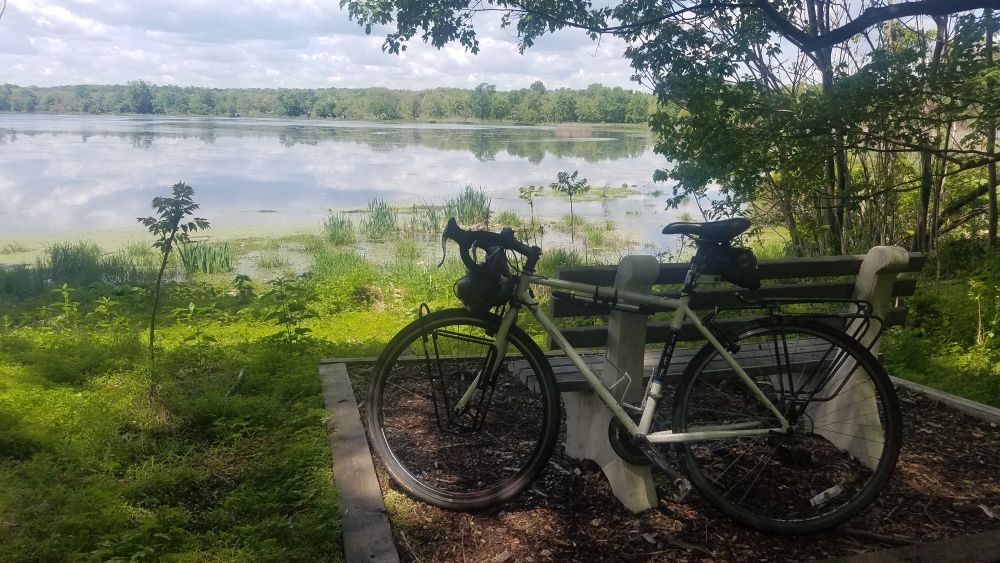
One of the many viewpoints of quiet lakes along the trail.
Starting at the south parking lot, you immediately get to travel north through Allamuchy Mountain State Park which has two beautiful lakes that you can stop and enjoy. Unfortunately, the first lake has you riding close to its dam and this area can severely flood under the wrong conditions. (We’re not kidding – check out this video!) Allamuchy State park used to have quarries and you can see the remnants of those as smaller ponds along the route. Eventually you will reach Cranberry Lake and you will get to ride along its shore. The trail enters a small commercial area here with a deli and then goes along Route 206, more or less through parking lots, and then as a dirt path on the side of the road. Eventually the road rises up above you and you are down lower, which means poor drainage after a rain. The good news is that Route 206 has wide shoulders here, so you can hop off and so some road riding if you want a break from the trail conditions.
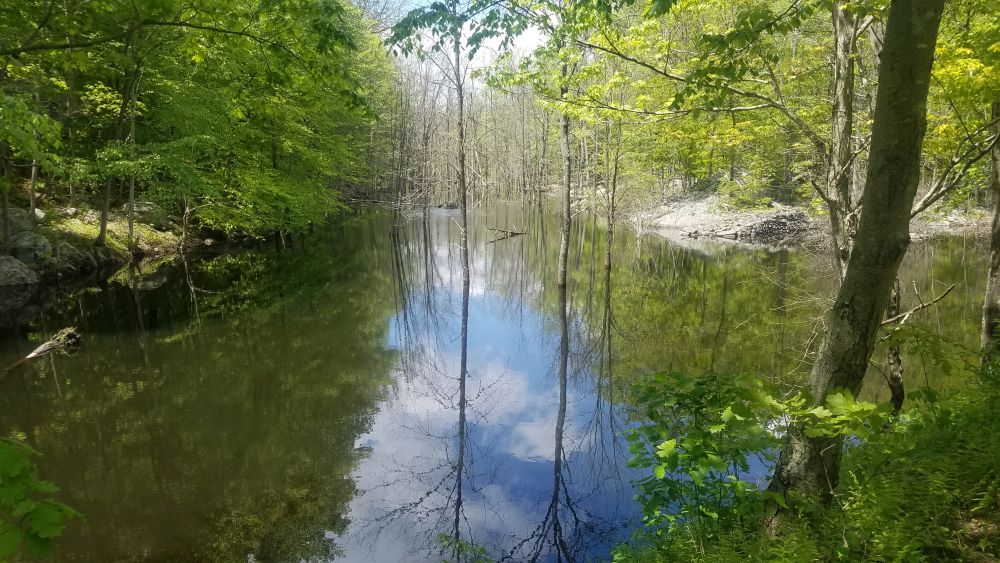
You can see these quarry ponds adjacent to the trail in Allamuchy Mountain State Park
At Whitehall Hill Road, there is a gap in the trail, but instead of riding along Route 206, you can ride along the much quieter Whitehall Hill Road, which parallels Route 206. At the junction of Whitehall Hill Road, Whitehall Road and Morris and Sussex Turnpike look for a little dirt path off to the right. That is where the trail picks up again. This time you are higher up, above Route 206. No flooding here, but it is bumpy. Take your time and push through. You’ll be rewarded by going over an old stone bridge. Shortly after you’ll arrive in Andover, which has a few restaurants and bunch of antique shops.
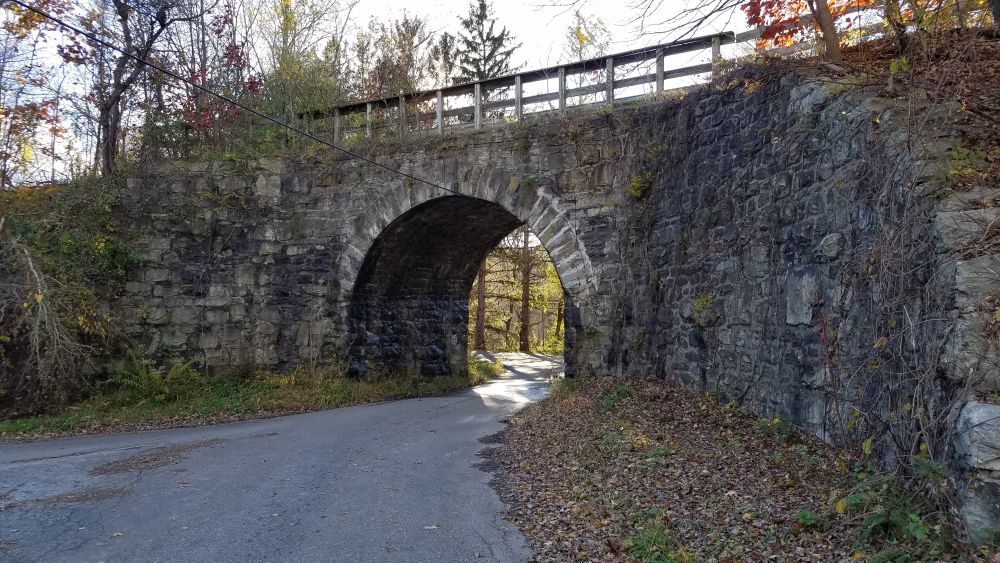
The trail goes over this stone bridge
North of Andover, the trail gets very quiet again as you veer away from Route 206 and head back into the woods. You will skirt along the east side of Newtown (another opportunity to access stores and restaurants) and you will need to ride on Hicks Avenue for a short distance to cover a break in the trail. After that, it is very quiet as you bike through the woods next to several streams. One interesting site you will see is the crossing of the Paulinskill Valley Trail high above you. This is another rail trail that was built on a line of the former New York, Susquehanna and Western Railroad. It is an uncommon sight to see two rail trail bike paths cross each other like this!
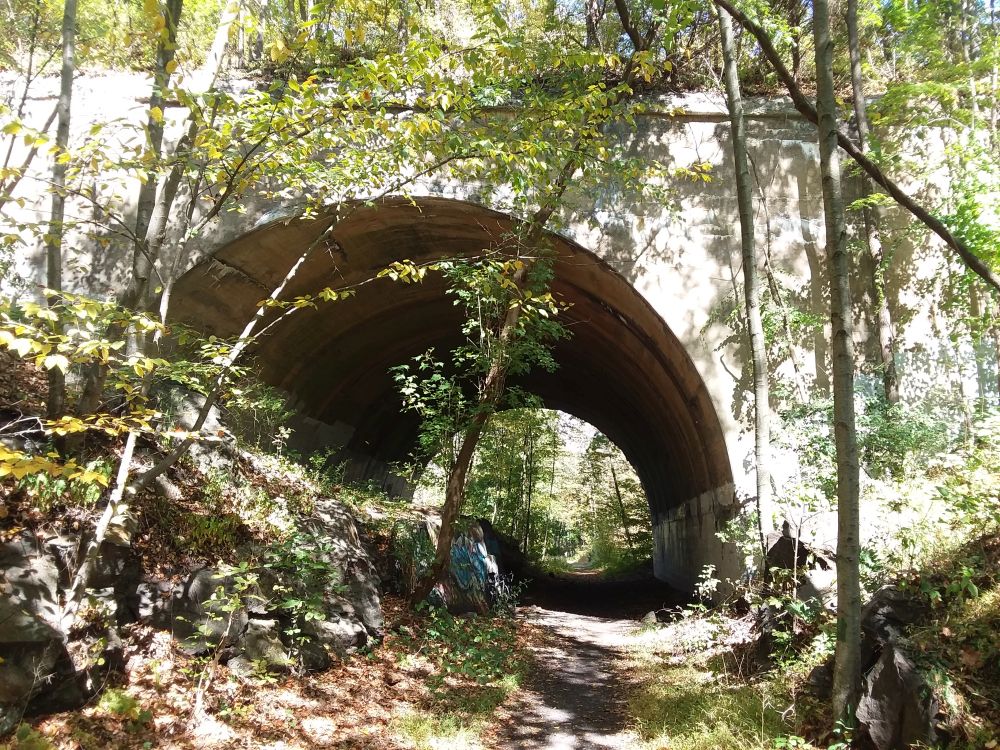
The Paulinskill Valley Trail passes high above you.
Soon after this crossing you will approach Lafayette Township where the trail starts going along Route 15. Fortunately, you are far enough away from the road to not be distracted by a lot of car noise. Also, at this point you are biking along the Paulins Kill, a rushing stream whose flowing water adds to the sounds you will hear. But you are never far from Route 15 which has restaurants and stores along it, particularly if you need a restroom.

A quirky trail-side sculpture garden welcomes you to Lafayette Township
The bike path flows in the same direction as the streams you will pass, which in a few miles takes you to Branchville where the Sussex Branch Trail ends. The trail ends unceremoniously on Mill Street and then it’s just a quick bike ride to the borough’s historic business district where shops and restaurants are available.
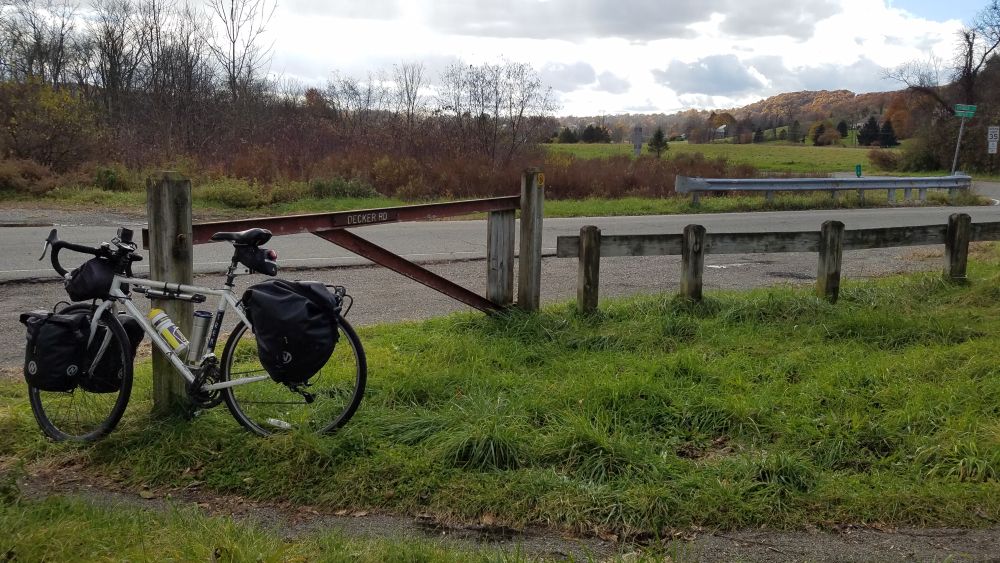
This bucolic farm scene is not very far from services located along Route 15 and the end of the trail in Branchville.
Spring 2019 Bike Path Update
/in Bike Hacks, Hudson Valley, NYC, Press, Rail Trails /by Laura WillisNow that it’s April, many cyclists are dusting off their bikes and heading out for their first ride of the season. And off-road bicycle paths are often the first places cyclists look to for those early season warm-up rides. The good news is that there are a lot of exciting bike path improvement projects heading to our region for 2019. Check out our updates below. And if you know of any other bike path improvement projects in the pipeline for this year, email us and we’ll update this posting again with the new information.
Don’t forget that there are great websites out there that catalog all the bike paths and bike routes in our region. These websites are great resources if you are looking to ride someplace new. Here are a few to check out:
https://www.facebook.com/njbikemap/
OK, on to the updates:
North County Trailway – Westchester County
The North County Trailway is one of three trailway segments that was constructed on the abandoned Putnam Division of the New York Central Railroad. Because the North County Trailway was also one of the first segments to be constructed on this rail line, some portions of the trail are now more than 20 years old and are in disrepair. However, the entire length of this trailway segment, between the Putnam County line and Old Saw Mill River Road in Tarrytown, will be resurfaced and repaired during 2019. If you ride the trail this year, be prepared for trail closures to occur anywhere along the trail. It may be worth checking the Westchester County Department of Parks, Recreation and Conservation Facebook page to see if they have information about trail closures before you head out for your ride. This trail is the prominent feature of our Hudson Valley Craft Brewery Bike Tour. If you do our tour, we can give you advance information of trail closures and we can shuttle you around them if they are impassible.
Harlem Valley Rail Trail – Dutchess and Columbia Counties
If you’ve ever taken the Metro-North Harlem Line train all the way to the end, you’ll notice that the Harlem Valley Rail Trail begins where the train tracks end. That’s because this rail trail was constructed atop the railroad abandonment, which constitutes all of the rail right-of-way north of the Wassaic station. This is one of the region’s most beautiful rail trails and it is a highlight of both our Hudson Valley Bike Tour and the Harlem Valley Rail Ride and Festival.
Over the years, it has been a challenge to construct a rail trail on top of the entire former rail line. An 8-mile segment has always been missing in between the Village of Millerton and Under Mountain Road in the Town of Ancram, which has necessitated that riders go on hilly (but beautiful) back roads to ride the whole trail.
However, construction has begun on this missing piece of trail and it is expected to be complete by October 2020. This will be a major undertaking requiring 4,100 feet of elevated boardwalks and the rehabilitation of six bridges. But when it is completed, it will surely be an amazing bike path. Read the whole story here.
Ocean Parkway Shared Use Path Extension – Long Island
If you are familiar with Jones Beach State Park, you might know about the Ocean Parkway Coastal Greenway, which is a great bike path that follows Ocean Parkway. Later this year construction will begin to extend this bike path for an additional 10 miles between its current terminus at Tobay Beach and Captree State Park. This bike path will greatly increase the amount of shoreline that is accessible by bikes in both Nassau and Suffolk Counties. The bike path is expected to be completed by the summer of 2020.
Verrazzano Bridge Summer Streets – Brooklyn and Staten Island
Have you ever done Summer Streets in Manhattan? It’s great. For three Saturdays every August, the City shuts down Park Avenue just for bikes.
It appears that support may be building to do the same thing on the Verrazanno Narrows Bridge. https://www.bikesbk.org/verrazzano-summer-streets/
The lack of a bike path or sidewalk on the Verrazanno Narrows Bridge has long been an issue for people looking to bike between the two heavily populated boroughs. The MTA has attempted to address this by providing bicycle racks on the S53 and S93 buses, but there is still a push to allow cyclists to simply ride across the bridge. This may be accomplished this summer if the Verrazzano Bridge Summer Streets intiative moves forward.
George Washington Bridge
A large number of cyclists (3700 per weekend day) routinely cross the George Washington Bridge, which was built in 1931 with narrow 7-foot wide sidewalks. The Port Authority of New York and New Jersey is currently undertaking a construction project to “Restore the George” which is anticipated to be completed in 2025. Because construction may impact the ability for cyclists to access the bridge sidewalks, the Port Authority recommends cyclists sign up for text or email alerts about sidewalk closures. Find out more at: https://www.panynj.gov/bridges-tunnels/gwb-pedestian-bicycle-info.html
However, it is important to note that the Port Authority’s “Restoring the George” project will not do much to improve bicycle mobility across this bridge, since the project is more or less only considering “replacement in-kind” of the existing sidewalks. To advocate for better improvements, all non-motorized users of the George Washington Bridge are strongly encouraged to go to https://completegeorge.org/ to learn more about how you can advocate for a better plan.
Mario Cuomo (Tappan Zee) Bridge
And finally, as this blog reported back in October of 2018, the long-awaited “shared use path” on the new Mario Cuomo Bridge is set to arrive later this year. This will be a major, major improvement for cyclists and pedestrians in the Hudson Valley. Check it out!
Riding New Jersey from End-to-End: High Point to Cape May on a Bicycle
/in New Jersey, Rail Trails, Wineries /by Laura Willis
If you are looking for a great 3- to 5-day bike tour that is scenic and diverse…and will also give you bragging rights for biking across an entire state, look no further than New Jersey. New Jersey is often overlooked as a bicycle tourism destination since so much of New Jersey’s image is negatively stereotyped with a car-focused identity: “Jersey barriers”, the Turnpike, Paramus’s shopping malls, etc. But the fact is, the New Jersey you can see from a bike is far different than the New Jersey you usually see from a car. New Jersey has an extensive bike trail network built on old canals and abandoned train lines that can take you long distances without seeing any cars. From a bike, you get a totally different version of the Garden State: one that has rolling Appalachian foothills, quaint mill towns, quiet streams, the scenic Delaware River, expansive farms, bright red cranberry bogs, fragrant pine forests, wineries, historic sites, and of course, beautiful beaches. New Jersey also has a robust bike-friendly transit system that can help get you to or from your ride, or give you plenty of options if you need to bail out part way. It’s a great bike tour that’s close by and only takes a few days to ride. You’ll also have a very favorable elevation change if you ride north to south, and the southern half of the ride is close to flat. Read on to find out more about what this ride is like and how to set it up.
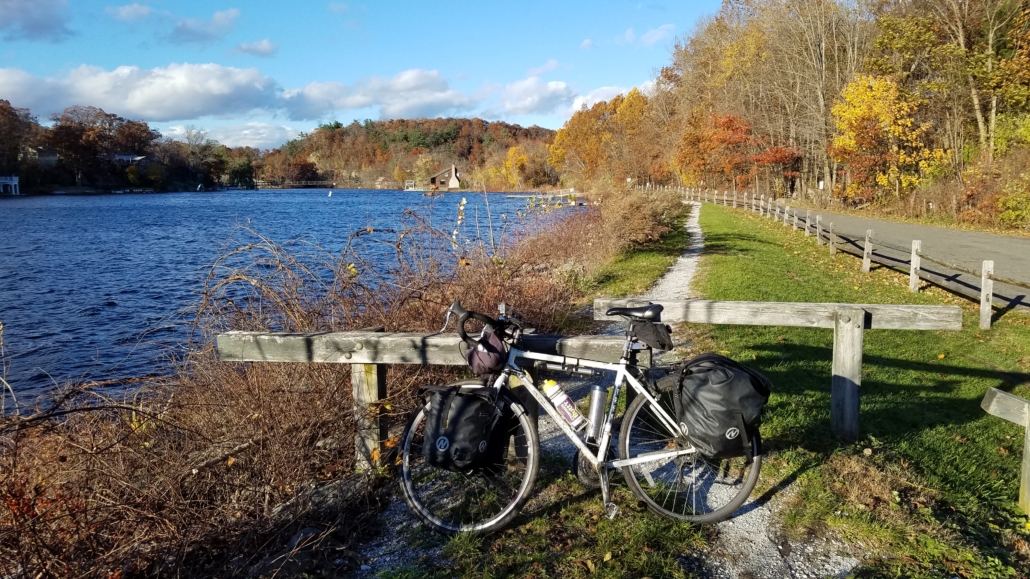
I did this ride by myself over four days in early November of 2018. It was a late foliage season, so I was hoping to get a run of four good weather days to do this trip and see the colors. I took a chance when I saw a 4-day forecast with temperatures staying around 45-55 degrees. But there was also a threat of rain. The weather turned out fine, with a mix of different conditions, but nothing awful.
Saturday – High Point and the Valleys Below
If you have the time, you can take the Metro-North Port Jervis line to the north end of this ride. I did not, so I did a one-way car rental and drove my bike to Port Jervis, NY. I drove out as early as I could on Saturday morning and I returned the car at an Avis location that was mainly a car repair garage (you better hope it’s open…). It was raining, but the forecast said the rain would end in 2 hours. Off in the distance, I could see the hills and High Point, with its obelisk jutting into the sky. The plan was to ride up there first and “tag the summit” before heading down the other side to the valleys below. While not a punishing grind, it was a steady ascent, and the beginning of a long day. But once I reached the windy top of High Point, the view was amazing. And it’s all downhill from here, right?

After descending High Point, I rode through beautiful farm valleys splashed with fall colors. The quaint downtown of Branchville was the starting point for the Sussex Branch Trail: a dirt-paved rail trail that goes through remote state preservation lands that are in the between old railroad towns. It is here where the ride is the quietest, with no traffic noise as you follow along streams and pass by lakes. But that rain that happened earlier? Well that left many, many puddles that I had to ride through. This trail is beautiful, so the difficult conditions did not deter me. However, if it had been a sunny dry day, it would have been far better.
Fortunately, a warm bed in an outstanding B&B was waiting for me in beautiful Long Valley. Located next to a horse farm, but close enough to bike into town for dinner, The Neighbor House B&B was an ideal setting.

Sunday – Columbia Trail and the D&R Canal Trail
Sunday I woke to cold but sunny conditions. Rafi, the owner of the Neighbor House, got me going with a generous breakfast and lots of encouragement. Next it was off onto the Columbia Trail, another rail trail travelling between Morris and Hunterdon Counties. This trail went through steep wooded valleys bursting with fall color and gently roaring with the sounds of streams swelled by yesterday’s rain. Paved with stone dust and cinder, the Columbia Trail is relatively smooth and a far easier ride than the Sussex Branch Trail yesterday. The trail ends in High Bridge, and from there I must ride on back roads to get to Frenchtown. The roads snake along brooks and streams which ultimately flow into the Delaware River. In Frenchtown, slow moving traffic ensured that I could take an entire lane width for myself as I made my way down to the waterfront, where lunch awaited at the Bridge Café . After that, it was 30 miles down the D&R Canal Trail, paralleling the Delaware River. It was a non-stop tunnel of color, with the river sparkling in between the trees as the sun positioned itself in the west. I would need to ride this section without stopping to ensure I made to my hotel before darkness fell.
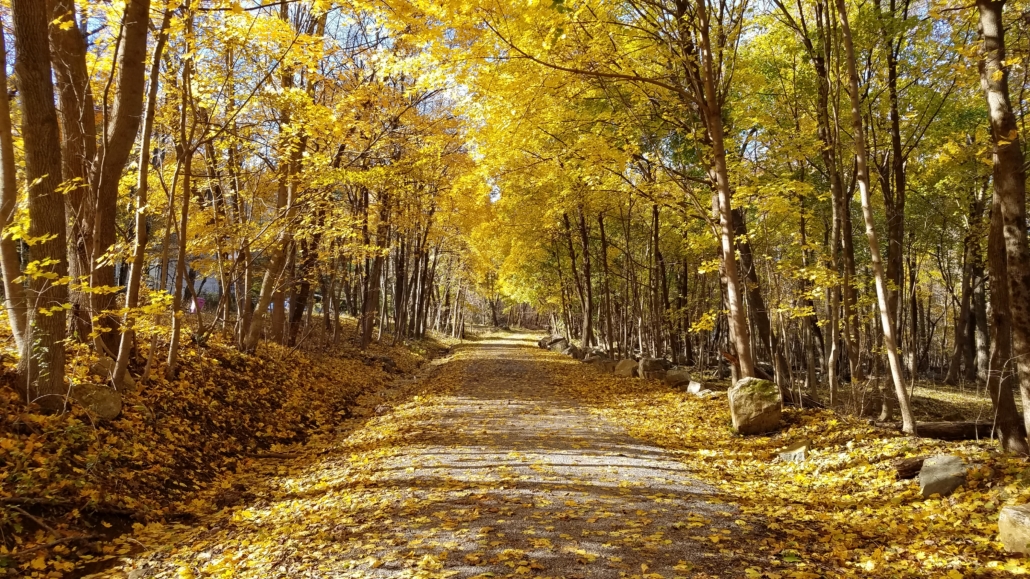
The quiet serenity of D&R Canal Trail continued, even as I passed through the only large city of my bike tour: Trenton. The path goes to the edge of downtown, where I jump off the trail and ride down State Street. It’s 5 p.m. on a Sunday and I have the entire street to myself. I ride past the capitol and beyond to the next trail segment: a park above a waterfront highway. This park, which celebrates the history of Trenton, leads to a ramp that brings you down to a bike path which runs next to the highway. But soon the path veers away and becomes another dirt path in a quiet forest area. The forest feels remote until you notice that you can still see the highway, and occasionally a light rail train flashes past. The path delivered me straight to the center of Bordentown, with its downtown clustered around a light rail station. It would be my jumping off point for the next day.
Monday – Farm roads and the quiet Pine Barrens
On Monday I headed east into the farm areas of Burlington County. The traffic was heavier because it was a Monday morning, but I managed to get an early start so I could get some miles in before rain overtook the area from the west. About an hour in, the rain started falling, but was already wearing my rain gear, so I was ready. An hour more in the rain meant I was ready to stop for breakfast at a diner. New Jersey has the best diners, so they make great breakfast stops if you want to get a little riding in first. I glanced at the menu and asked myself if it was worth trying pork roll again. Pork roll is a product of Trenton, so it’s mainly found in New Jersey and the immediate areas surrounding it. I skip it – it’s raining out, do I really want heartburn too?
Back on the bike it rains as I ride through Fort Dix and into the Pine Barrens. The roads get very quiet and all the roads have bike lanes. Sometimes there are other paved roads that I can take through state forests. These roads have absolutely no cars.
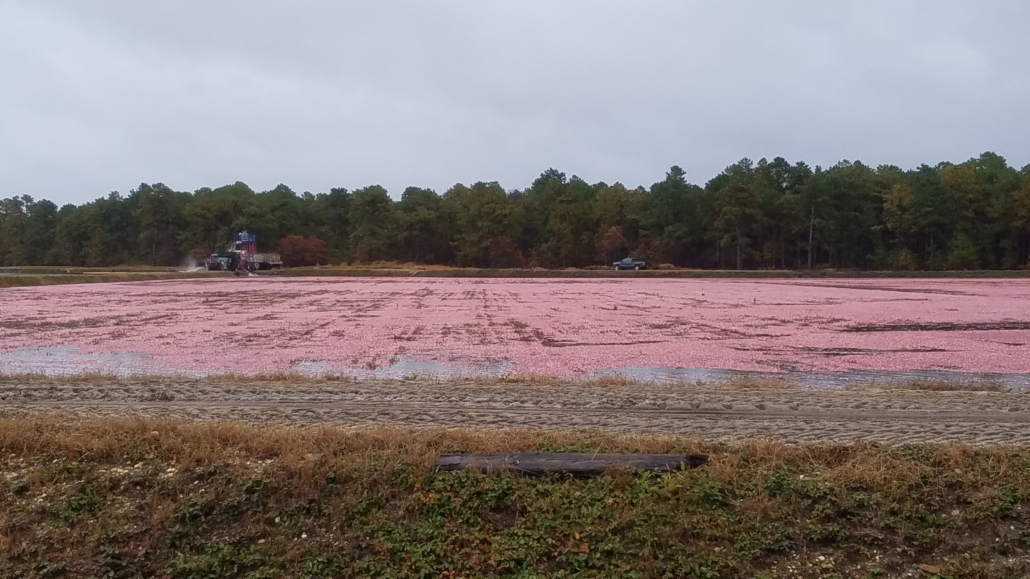
The rain falls more gently now as I pass the vibrantly red cranberry bogs that are being harvested for Thanksgiving. Red cranberries litter the road as I ride to Egg Harbor City where I check in at the Tuscan House of the Renault Winery. This winery is famous since it is the second oldest winery in the United States. To do this, it had to survive Prohibition. And for that, just look a few miles to the east to Atlantic City. Once ruled by mobsters during the Prohibition Era, the winery was part of their racket. Fans of Boardwalk Empire would find this winery interesting!
Getting my bike into my huge room was easy. The staff were helpful and the onsite restaurant was a great place to relax before going to bed.
Tuesday – Finishing at Cape May
The winery did not have any on-site breakfast available the day I was there, so I ate an energy bar and I took off as the sun was rising. This would be my last day of riding, and the plan was to pick up a rental car in Cape May and drive it home. But it’s a long drive and the car rental shop does not have late hours, so an early start was key. Thankfully, there was no rain as I ride south along Route 50, which has a generous shoulder, but also a good deal of traffic. Mays Landing, the County seat of Atlantic County, was a great place to stop for breakfast. It was also Election Day, so the historic buildings were decked out in red-white-and-blue bunting. This time, I’m confident in my ability to finish my final day, so I order the pork roll. But I eat only half of it. Too much sodium and fat!

Back in the saddle, it’s grey and foggy. Once I cross the bridge into Cape May County I am able to take advantage of a number of lower-traffic county roads as well as paved bike paths which traverse down the Cape May Peninsula. And even though I got a flat tire after breakfast, I am still on schedule, which allows me time to check out the Hawk Haven winery. The tasting is wonderful. It’s a Tuesday and I have the place to myself and I am able to ask all about their wine. I decide to buy a case to bring home to share with my wife, so they hold the wine for me behind the counter. I’ll come back for it later after I get my car.

A few miles later and I am arriving at Cape May point. It’s about 2 p.m. on a Tuesday, and I have the place all to myself. I do the obligatory picture of the lighthouse and then I walk to the beach and enjoy the sight and sound of the ocean as I breathe in the fresh salt air. I need to ride 6 miles back to pick up my rental car, so I decide to take a different route back along the shorefront. I then pick up my rental car, go pick up my wine and head back to NYC. And I even made it in time to vote!
Trip Costs
I did this trip myself, with no support. I arranged all of the accommodations myself, I spent about 20 hours planning the route and I drove myself to and from the ride using one-way rental cars. I spent about $730 for the entire four days and it was a lot of work to figure this out.
Gotham Bicycle Tours can arrange a tour for a small group that is cost-competitive with doing the ride on your own. For about $3300 (plus hotel expenses) we could provide a group of 4 people with a complete tour, with all lodging pre-arranged, a route specifically chosen to fit your group’s interests and GPS navigation. You would also have full van support for the entire ride with rest stops arranged for you. You would always have access to a well-stocked cooler in the van. We can also help get you and your bikes to the start and end points of the ride, saving you lots of time. (This is key since we can drive you to the TOP of High Point to being your ride!) And you wouldn’t need to spend an enormous amount of time planning out your route!
Contact me at Lukas@gothambiketours.com or call 917-748-1119 for ideas about planning your end-to-end tour of New Jersey.
The Harlem Valley Rail Ride Weekend is in the News!
/in Hudson Valley, Press, Rail Trails /by Laura WillisThe following is a re-posting of an article from the Millerton News, a local newspaper in the Village of Millerton. The article was published on July 25, 2018 and was written by Kaitlin Lyle.
Cyclists take to the Rail Trail
Kaitlin Lyle
MILLERTON— Once again, the Harlem Valley Rail Ride has brought together cyclists from across the state to experience the region’s beauty on Sunday, July 22.
Organized at Eddie Collins Field, cyclists could pitch a tent on Friday, July 20 until Monday, July 23.
There was a free bonus warm-up ride with a choice of a 12-mile route up the Harlem Valley Rail Trail or a 25- to 35-mile route.
Whether emerging from their tents or riding their bikes, cyclists from all walks of life and levels attended the ride. Cyclists could enjoy a 100-mile route, a 72- to 80-mile route, a 45- to 57-mile route or a 23- to 33-mile route.
On top of their preparations for their ride around the Harlem Valley, cyclists enjoyed breakfast underneath the park pavilion. Despite the gray clouds overhead and hint of rain on the way, they were determined to put the pedal to the metal as they had chosen.
Whether they were riding solo, with their loved ones or making friends on the ride, there was a discernible camaraderie at summer’s most beautiful ride.
On top of enticing cyclists from all around the state, the event motivated a couple organizations from the surrounding area to lend a hand.
Underneath the pavilion, members of the American Legion Post 178 in Millerton cooked up a storm, serving breakfast and lunch. The Dover High School basketball team volunteered by parking cars and doing other similar tasks; a donation was made to the team. Gotham Bike Tours helped set up the tents for campers overnight in addition to picking visiting cyclists up and bringing them back to the train station. All the way from the Westchester Beemers Motorcycle Club, volunteer “motos” offered free motor service to cyclists in need.
With the storm slowly rolling in, volunteers checked on cyclists who were still on the road. While the weather had its sunshine and dark clouds, cyclists made their way back to Eddie Collins Field.
“I think this event is really good for Millerton,” said Lukas Herbert from Gotham Bicycle Tours. “It really puts Millerton on the map and brings people out, especially city people who have never heard of it.”
The Farmington Canal Heritage Trail – A Car-Free Ride Across Connecticut (and part of Massachusetts)
/in Connecticut, Rail Trails /by Laura Willis
Most people have no idea, but Connecticut is one of the few states that you can cross end-to-end on a car-free bike path: the he Farmington Canal Heritage Trail
But it gets even better: you can also go an extensive distance in Massachusetts as well, on the same bike path for an even bigger ride.
It still gets better: the bike path connects to well-marked on-road bike route networks in Massachusetts once the trail ends.
It STILL gets better….you can leverage a new commuter rail system to do your epic ride one way.
So what’s the deal? Why don’t you know about this trail yet? Well, I am going to tell you. This trail is awesome! It is so well put together, you’ll think you are in Germany, riding down a scenic radweg, designed by engineers and landscape architects who really care about bikes. Except the Dunkin’ Donuts you just passed will remind you that those dedicated professionals who put this trail together are from Connecticut…and wow – what a great trail.
The main issue with the elusiveness of this trail probably has something to do with the fact that it changes names as it goes through different areas. And, of course, you have to go to different websites to get the maps for the differently named trail sections. So that makes it trickier to put your ride together. But make no mistake: you can ride from Amherst, MA to New Haven, CT with only a small amount of on-road riding. And those on-road sections are shrinking as gaps in the trail continue to get bridged with new trail segments. And where the gaps exist, there’s good signage to keep you moving. And sometimes there’s trail alongside the road where you can ride without dealing with cars. Amazing!
 Massachusetts Section
Massachusetts Section

Connecticut Section
Although this trail is called a “canal heritage trail” since it follows the route of a canal that once went from New Haven to Northampton, the canal was mostly obliterated by the railroads that came in later. So the trail is basically a rail-trail, laid down where the tracks used to go. It is all paved, and you go through town after town after town….so plenty of services, places to eat, places to stay, etc. And don’t forget that the trail closely parallels the new CT Rail commuter rail service in between New Haven and Springfield, which accommodates bikes. You can also bring your bike aboard the Amtrak Vermonter if you want to travel further north on the train to Northampton or beyond.
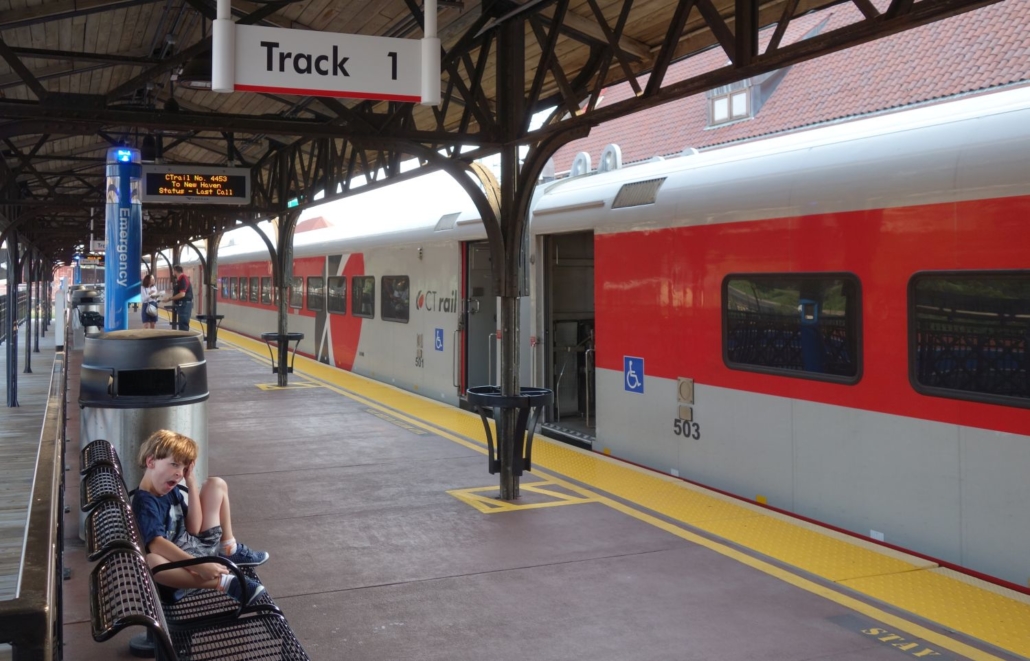
New CT Rail trains parallel this bike trail, offering good bike-friendly transit access
Here’s a breakdown of the the Farmington Canal Heritage Trail (and the segments with other names) from North to South:
Norwottuck Rail Trail – https://www.mass.gov/locations/norwottuck-rail-trail While not directly a part of the Farmington Canal system, this rail trail hooks directly into the trail Northampton. It provides a great extension of the trail between Amherst and downtown Northampton where it hooks directly into….
Manhan Rail Trail – https://manhanrailtrail.org/ This is the name of the trail once you leave Northampton and get into East Hampton. (Within Northhampton it’s just called part of the city’s bike path system).
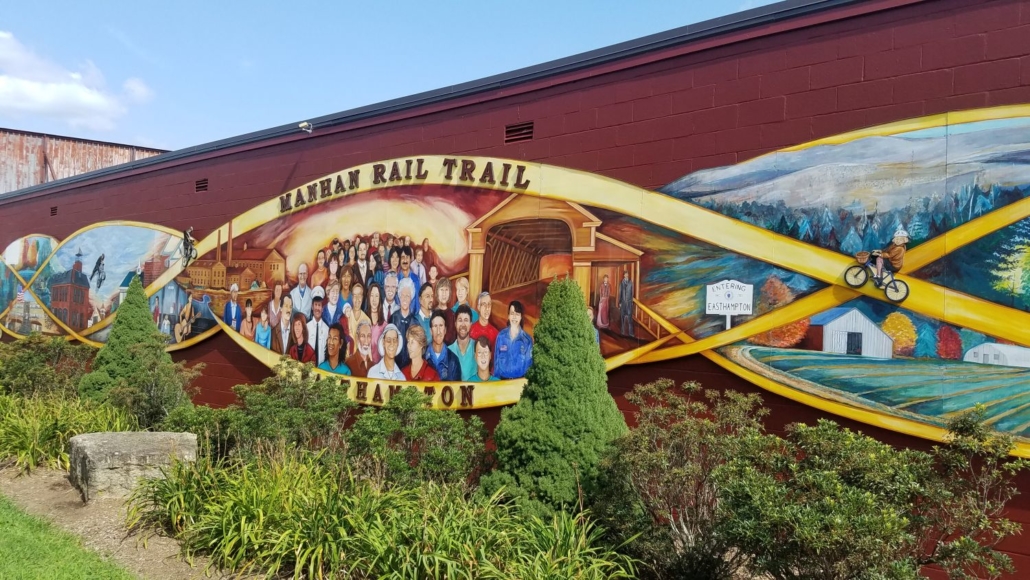
On road riding – When you get to the town of Southampton, the Manhan Rail Trail ends and you will have to take local streets. Unfortunately, the signage is not good in this one area, so you will have to plot out a route that generally follows Route 10. It’s about 10 miles to the City of Westfield, where the trail picks up again. But after that, it’s all smooth sailing on bike paths for almost the rest of the time.
Columbia Greenway Rail Trail – https://www.columbiagreenway.org/ And just like magic, tucked behind a Stop & Shop is the Columbia Greenway Rail Trail which takes you from Westfield through beautiful agricultural areas, including tobacco fields! (Who knew they grew tobacco in Massachusetts?) This trail takes you all the way to Southwick where it becomes….
Southwick Rail Trail – http://southwickrailtrail.org/ Another name for the same great trail. This time in Southwick, Massachusetts. Southwick is the last town in Massachusetts. After this you enter Connecticut and start riding on….
The Farmington Canal Heritage Trail – http://fchtrail.org/ Thankfully, the rest of the trail is under the same name with the same maps and website. This is where the trail really begins to shine as you pass through many towns where the trail right-of-way had been interrupted by development, only to be put back together by trail designers who routed the trail through office parks and along trails adjacent to streets. You’ll pass through town after town on this well-maintained trail, with plenty of businesses to stop at. The trail runs generally uninterrupted until you reach Plainville, but at that point the trail is also marked as….
The East Coast Greenway – https://www.greenway.org/ Just north of Plainville, the Farmington Canal Heritage Trail is co-branded as the East Coast Greenway, which is a larger trail system spanning between Florida and Maine. So when the trail gets interrupted in Plainville, you just follow the East Coast Greeenway markers to keep going on your route.
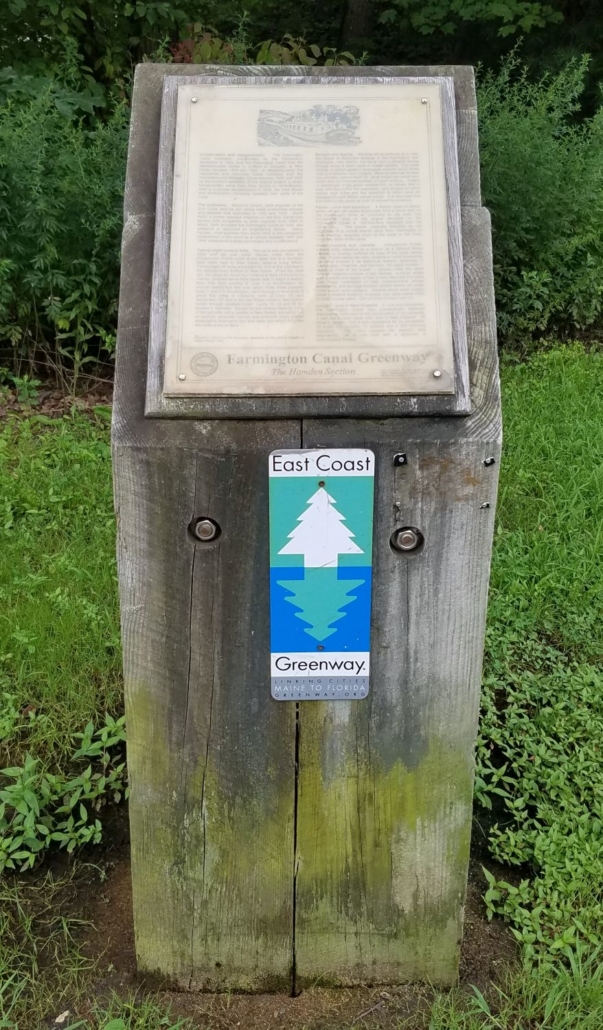
Eventually, you’ll reach the next segment of the Farmington Canal Heritage Trail and you’ll keep riding. As you ride south, you’ll notice that the trail gets very wide, which is great since there are a lot of people on it. The trail continues on, with only one small interruption until you get to New Haven where the trail ends at the Yale Campus. Take your time to enjoy the New Haven Green, or just pedal the short distance to the train station and be on your way. You can get trains to almost anywhere from New Haven’s beautiful Union Station.

Union Station serves Metro-North, Shoreline East, CT Rail and Amtrak trains. Go anywhere!
Riding the Harlem Valley Rail Trail
/in Hudson Valley, Press, Rail Trails /by Laura Willis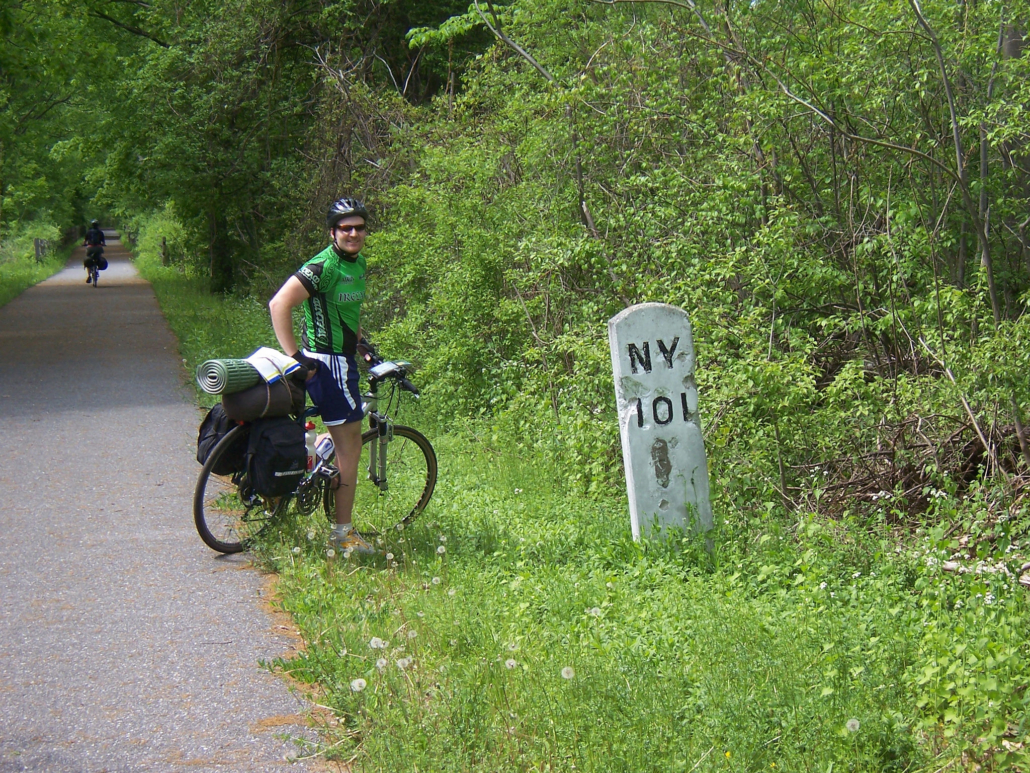
The Harlem Valley Rail Trail is one of the most beautiful rail trails in New York State. It’s also one of the easiest to get to since begins in a Metro-North train station parking lot. The Harlem Valley Rail Trail also has lots of amenities along it’s route including farmers markets, restaurants and swimming holes. It’s the perfect getaway for a day ride. And it also makes for a great destination for two of the tours we offer at Gotham Bicycle Tours: our Hudson Valley Bike Tour and our Harlem Valley Rail Ride Weekend. We also run private tours on this trail, because it is so nice!
The Harlem Valley Rail Trail can trace its history back to 1852, when the New York and Harlem Railroad was constructed as far north as Chatham, New York. The New York and Harlem was one of America’s oldest railroads, which was eventually absorbed into the New York Central, and ultimately into Metro-North Railroad as the Harlem Line. However, by the time Metro-North Railroad acquired the line, commuter rail service only went as far north as Dover Plains, with the rest of the line being abandoned.
Fortunately in the late 1990’s, Metro-North undertook an extension of the Harlem Line to Wassaic, NY. As part of the extension, the Harlem Valley Rail Trail was built on top of the abandoned rail alignment north of Wassaic. With this project, the first “intermodal” train to bike hub was created in the New York Metro region.
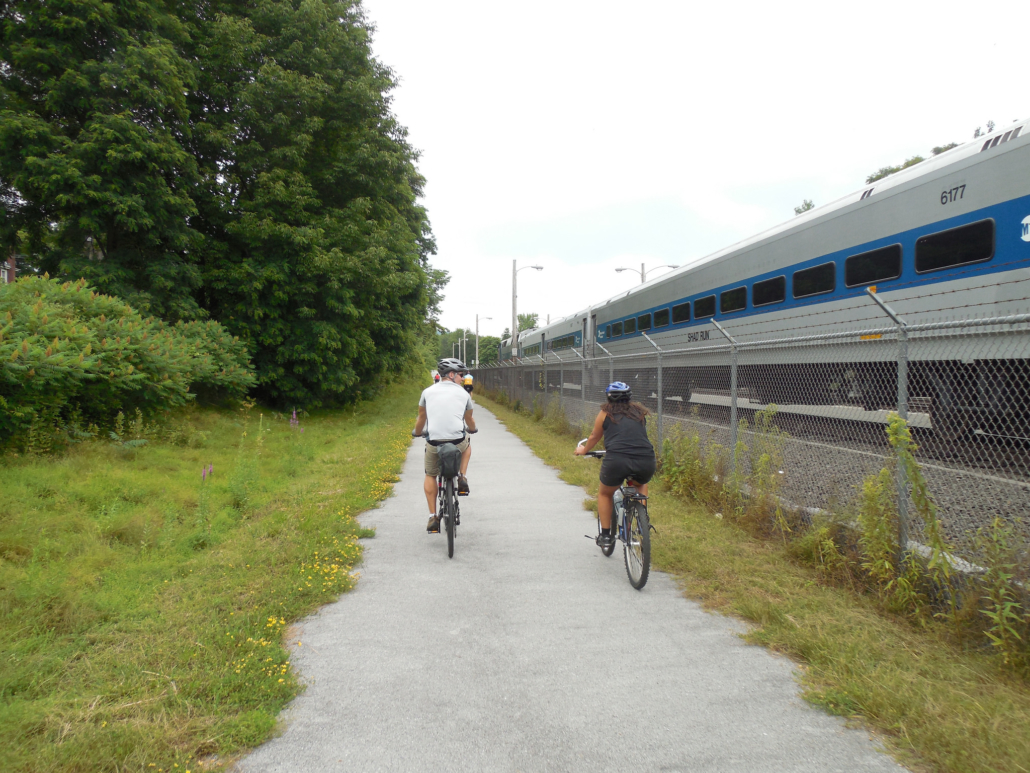
The trail goes right by the Wassaic Metro-North station.
The Harlem Valley Rail Trail is currently open as a 23 mile trail between Wassaic and Copake Falls. Full information and maps can be found at the Harlem Valley Rail Trail Association’s website at: http://hvrt.org/
The amenities on this trail are some of the best around. There are always plenty of places to eat in Millerton, 11 miles north of the trail start in Wassaic. On Saturdays you can even grab lunch at a great farmers market that has all kinds of wonderful food from all of the farms you just rode past on your bike.
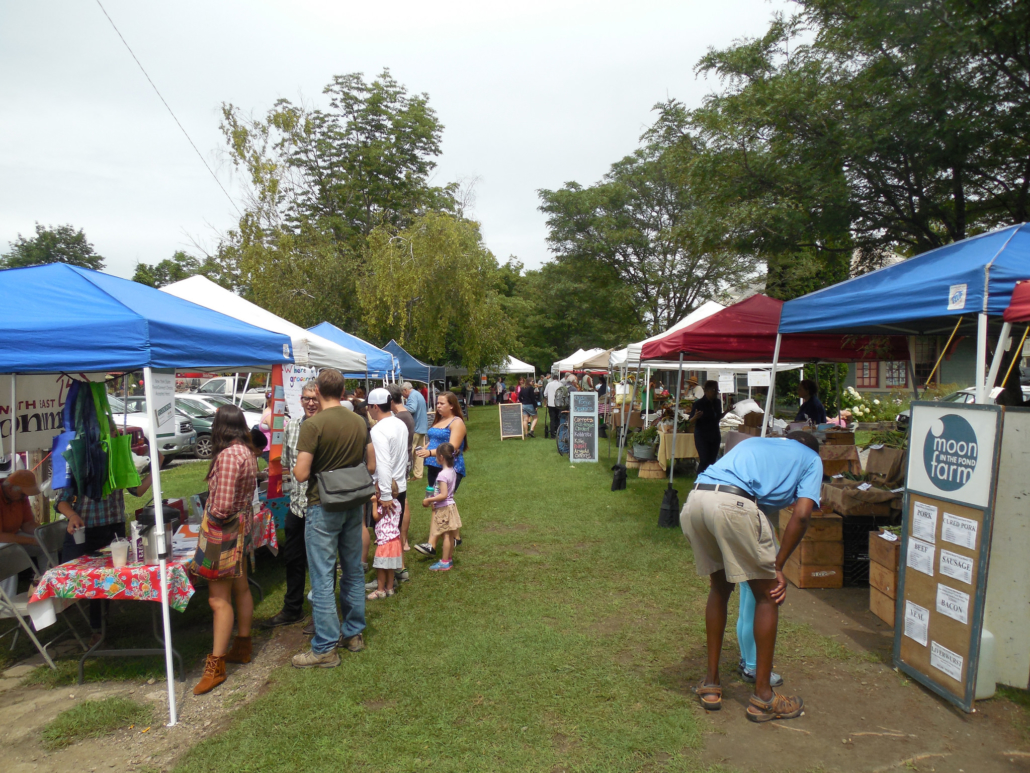
As you push north, you’ll pass Taconic State Park in Copake Falls which has camping, a waterfall hike…and a great lifeguarded swimming hole in an old quarry that is super refreshing on a hot summer day.
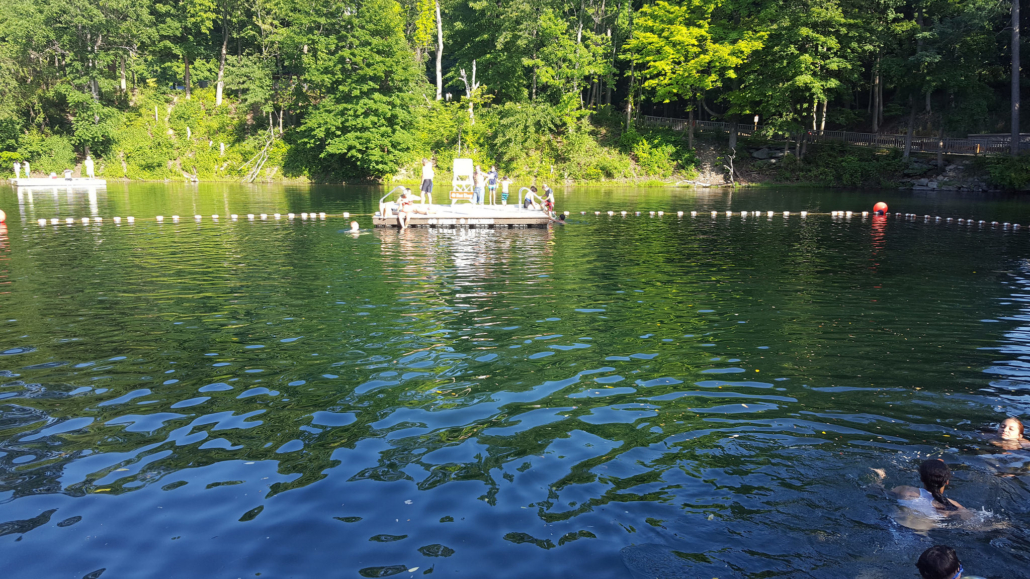
Just north of the park is one of the most scenic segments of the trail, where you ride through a lush valley. The first time we rode through this spot with our 6-year old son, he asked us “is this God’s world?” because it looked like the pictures he had seen of Heaven!
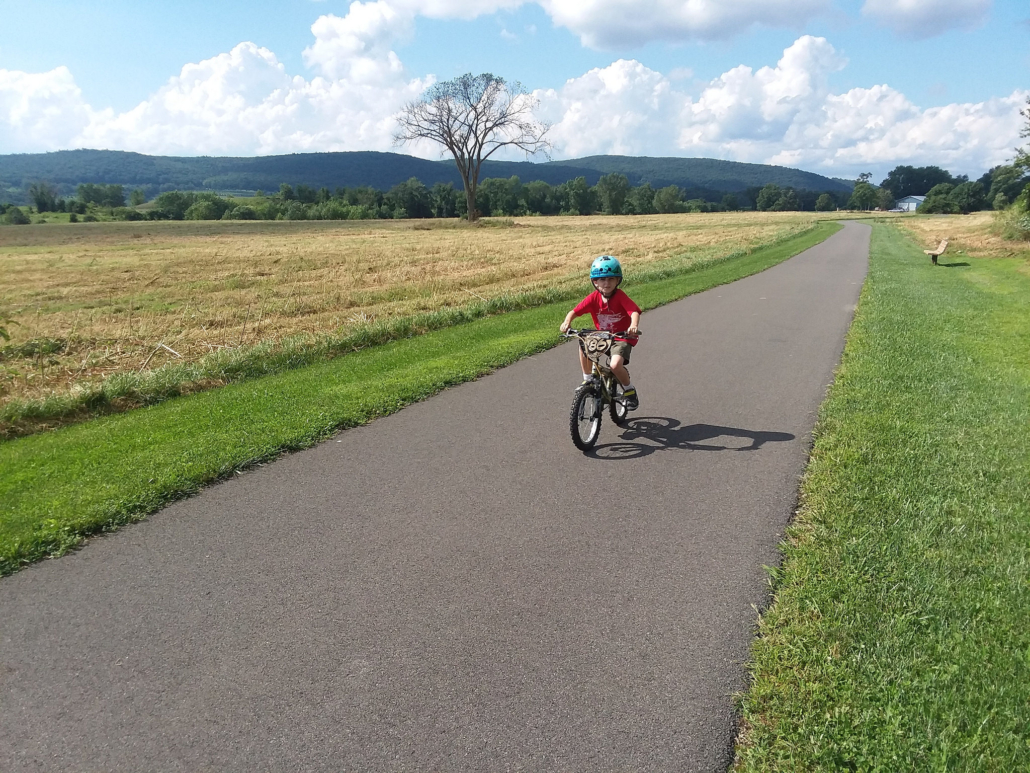
Riding the Catskill Scenic Trail
/in Catskills, Rail Trails /by Laura Willis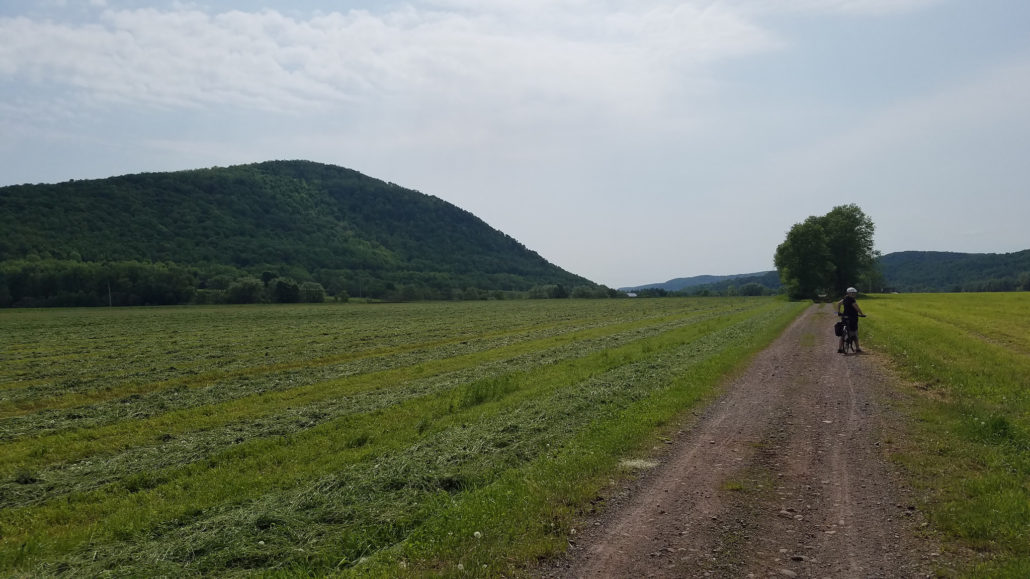
The Catskill Scenic Trial is one of the most beautiful rail-trail bike paths anywhere near the New York Metropolitan Area. Framed by both mountains and farms, this 26-mile, car-free ride is a perfect outing for a day or a weekend. But the beauty of this trail is thanks to it’s out-of-the-way location that takes you along the headwaters of the Delaware River. Trail conditions are also somewhat rugged if you are used to riding on paved surfaces. But we believe this ride is so nice that it’s worth the effort. To see the most of this trail, it’s best to be able to ride it one way using a car shuttle. Gotham Bicycle Tours will be offering car shuttle services in 2020 on certain weekends.
Getting to the trail.
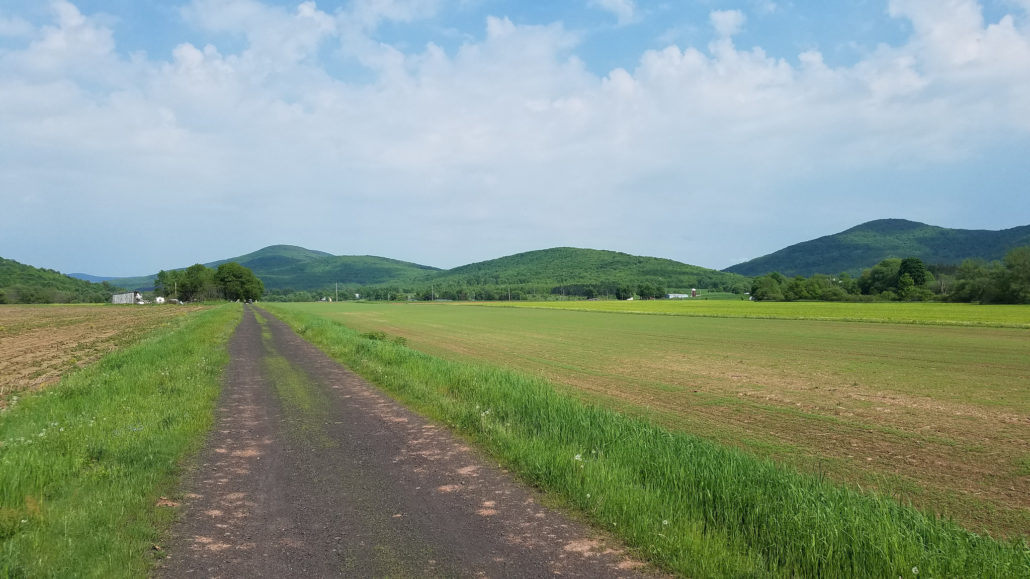
One of the many wide open spaces the Catskill Scenic Trail will take you through.
The Catskill Scenic Trail is located in the northwestern portion of the Catskills, mostly in Delaware County, but also within a portion of Schoharie County. It’s about a 3 or 4 hour drive to get to the trail from New York City, depending on the route you take and the traffic. The trail is not served by public transportation, so you must drive to the trail or find a ride. But once you are there, you’ll quickly find out that it was worth the effort to get there.
A good place to start for planning your ride is to think about where you will park. The Catskill Scenic Trail website has a great map of the trail that shows the communities that the trail passes through, as well as where to park. The trail generally runs east-west in a upside-down U shape, and trail conditions are generally better for riding at the western end. There is a formal parking lot at the western end in Bloomville as well as trailside parking in Stamford. Hobart, located in between, also has some municipal parking lots near the trail. In addition, there are also less formal dirt lots near where the trail crosses roads. Wherever you park, keep in mind that you will need to ride out on the trail, and then turn around to come back, to get back to your car. Doing the ride one-way with a car shuttle allows for more flexibility, particularly if you are interested in doing the more difficult sections at the eastern end of the trail.

Most of the old railroad mile markers are still standing along the Catskill Scenic Trail, indicating the number of miles to Kingston.
The riding experience.
This trail used to be part of the Delaware and Ulster Railroad, which once chugged into the Catskill Mountains between Kingston and Oneonta. The last train ran in 1976. Since that time the 26 miles between Roxbury and Bloomville has been transformed into a bike path. And the section between Roxbury and Arkville now operates as a scenic railroad. Most of the trail still has the old mile markers from the railroad’s days of operation, with distances shown to Kingston. The railroad generally made use of the flat terrain along along both the the West Branch and East Branch of the upper Delaware River, and the trail takes you near the headwaters of both branches, hundreds of miles away from where the river empties into Delaware Bay.
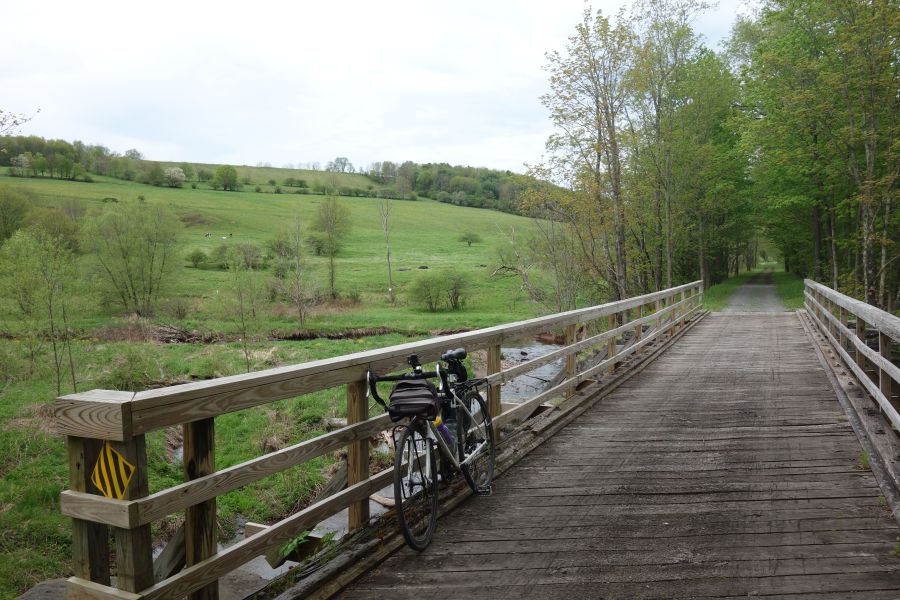
A quiet bridge that crosses the meandering West Branch of the Delaware River.
The experience this trail offers is rugged and remote, although the trail is generally flat. The western portion of the trail, that runs along the West Branch Delaware River generally between Bloomville and Stamford, has the best conditions. But you should be aware that the trail conditions change back and forth between gravel, dirt, stone dust and grass. Depending on the season, the grass can be tall, so you will want to bring bug spray to spray your legs to protect against ticks and mosquitoes.
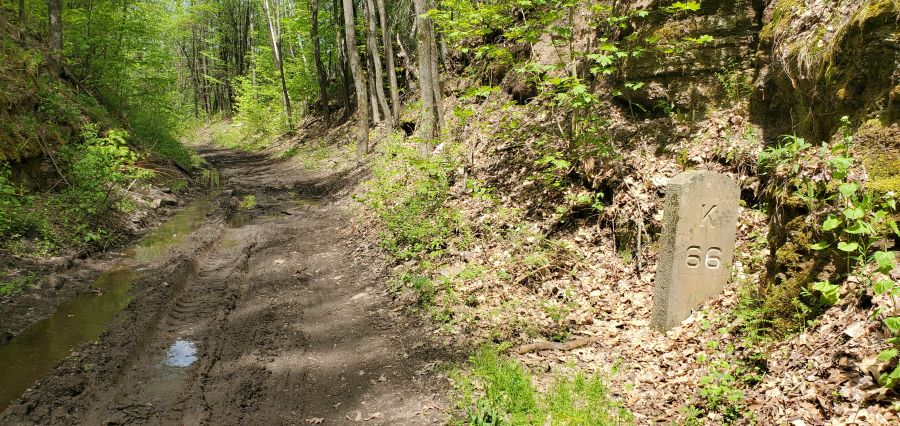
One of the rougher sections of trail to ride.
In Stamford you reach the headwaters of the West Branch Delaware River and you begin to transition over to the East Branch. This transition area is one of the tougher parts of the ride, particularly the portion between Route 23 and Route 30 near Grand Gorge. This part of the trail is the only part that does not go along a waterway and the trail conditions are rocky and muddy, thanks to poor drainage. Take your time here and walk your bike if you need to.
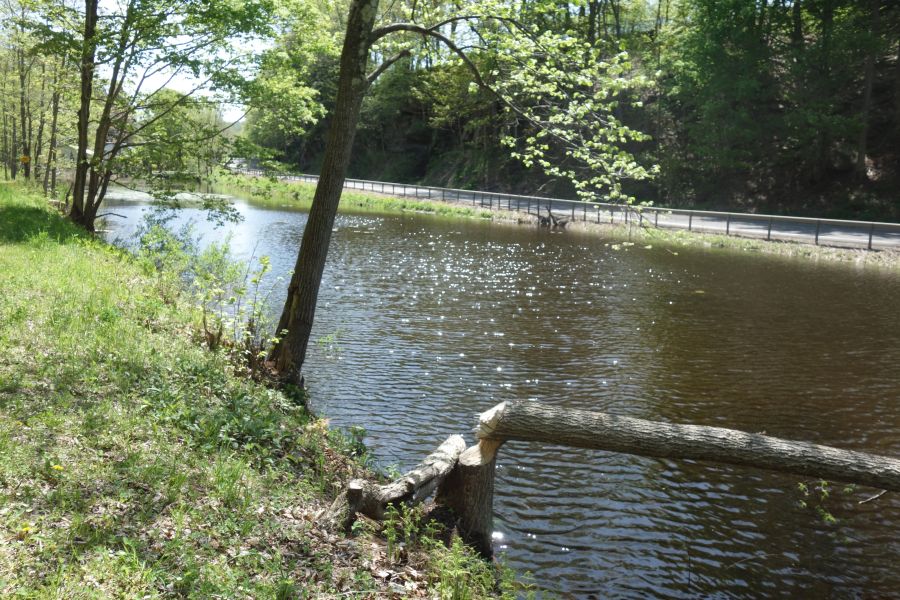
Keep on the lookout for beavers as you ride along the East Branch of the Delaware River.
Once the trail crosses Route 30, you will now be along the East Branch Delaware River whose source is a small pond behind a large pile of tires. The riding gets easier again here, although it still can be rugged thanks to the beavers who live here. It is not uncommon to find beaver dams that cause flooding along the trail. So be ready to ride through sponge-like grass and mud depending on the current construction projects these beavers may be undertaking. Also, the grass back here can be very high depending on the season, so bring bug spray so you can enjoy the beautiful views without getting bit by ticks and mosquitoes.

Uh oh, some beavers built a dam creating a lake across the trail. Time to make a detour!
Services and restrooms.
Given the remoteness of this trail you should also carefully plan your day based around the services you can obtain along the trail, in addition to the parking lots discussed above.
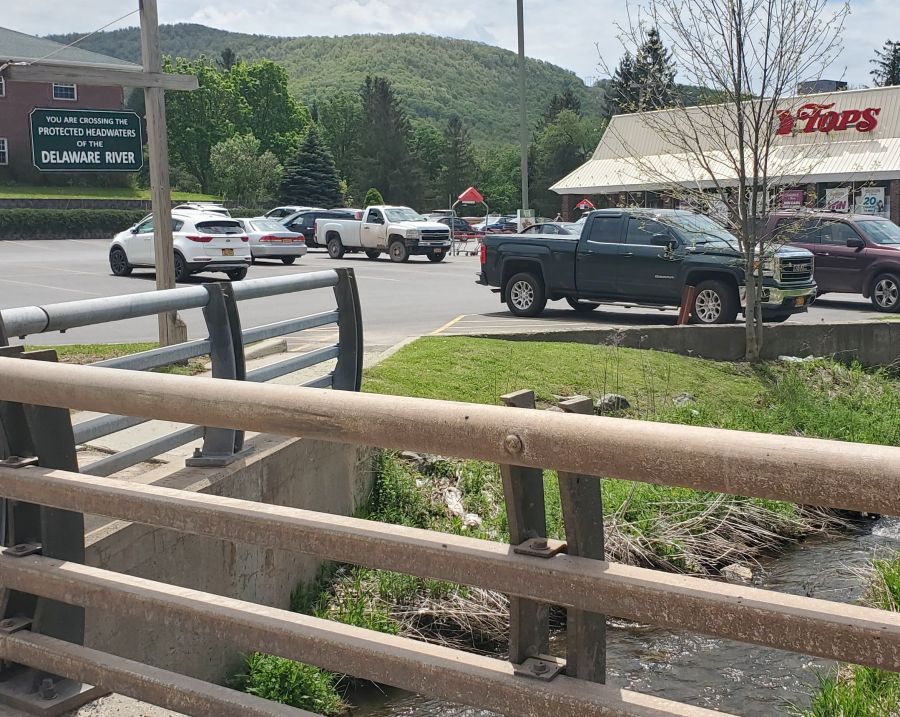
The Headwaters of the Delaware River are located right behind this supermarket in Stamford.
The largest commercial area along the trail is in Stamford, although you will need to ride a few blocks away from the trail to find the supermarket, a convenience store and an ice cream stand. Services can also be found in Hobart, where the Village has placed a map showing where services are located along the trail. Roxbury and Grand Gorge have services, but they are a further ride from the trail (with the exception of Sundaes Restaurant and Tasty Freeze, just to the west of Grand Gorge). There are no formal restrooms or portable toilets along the trail, but you can usually find restrooms at businesses located in these areas. Please note that because these communities are very small, some businesses may not be open every day. So call ahead before you start riding. You don’t want to arrive at a restaurant hungry, only to find that it is closed that day!
Upcoming Bike Tours
Learn More
Would you like more information about our tours?

